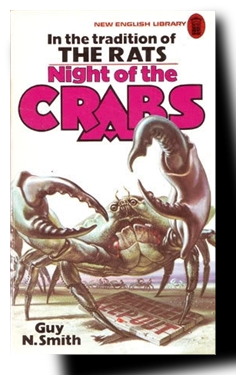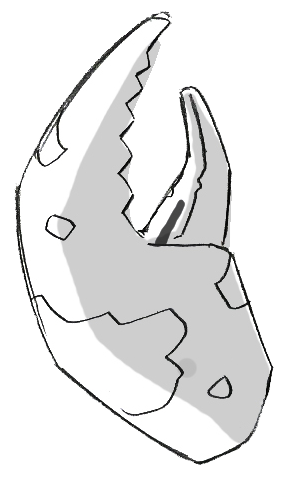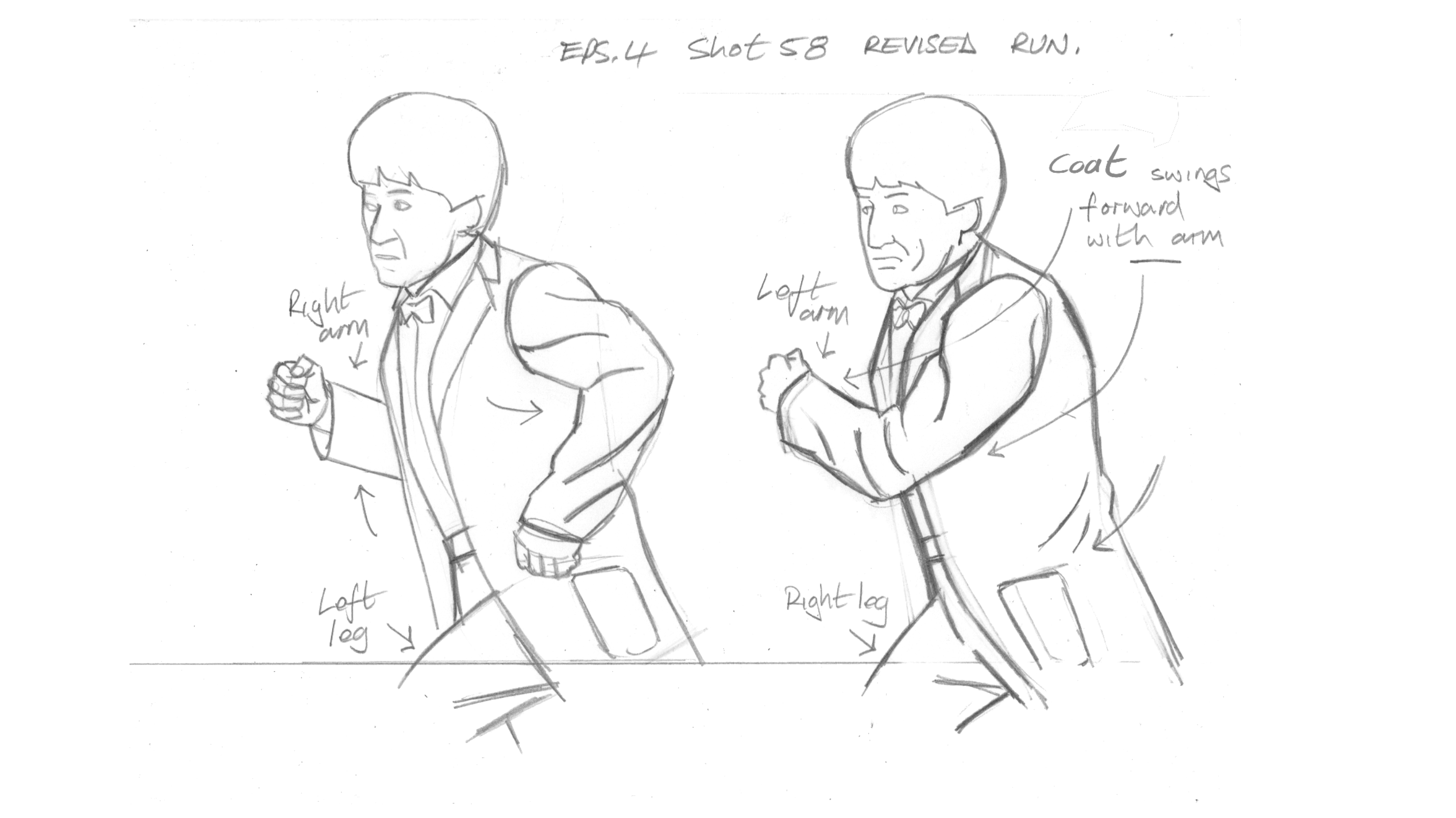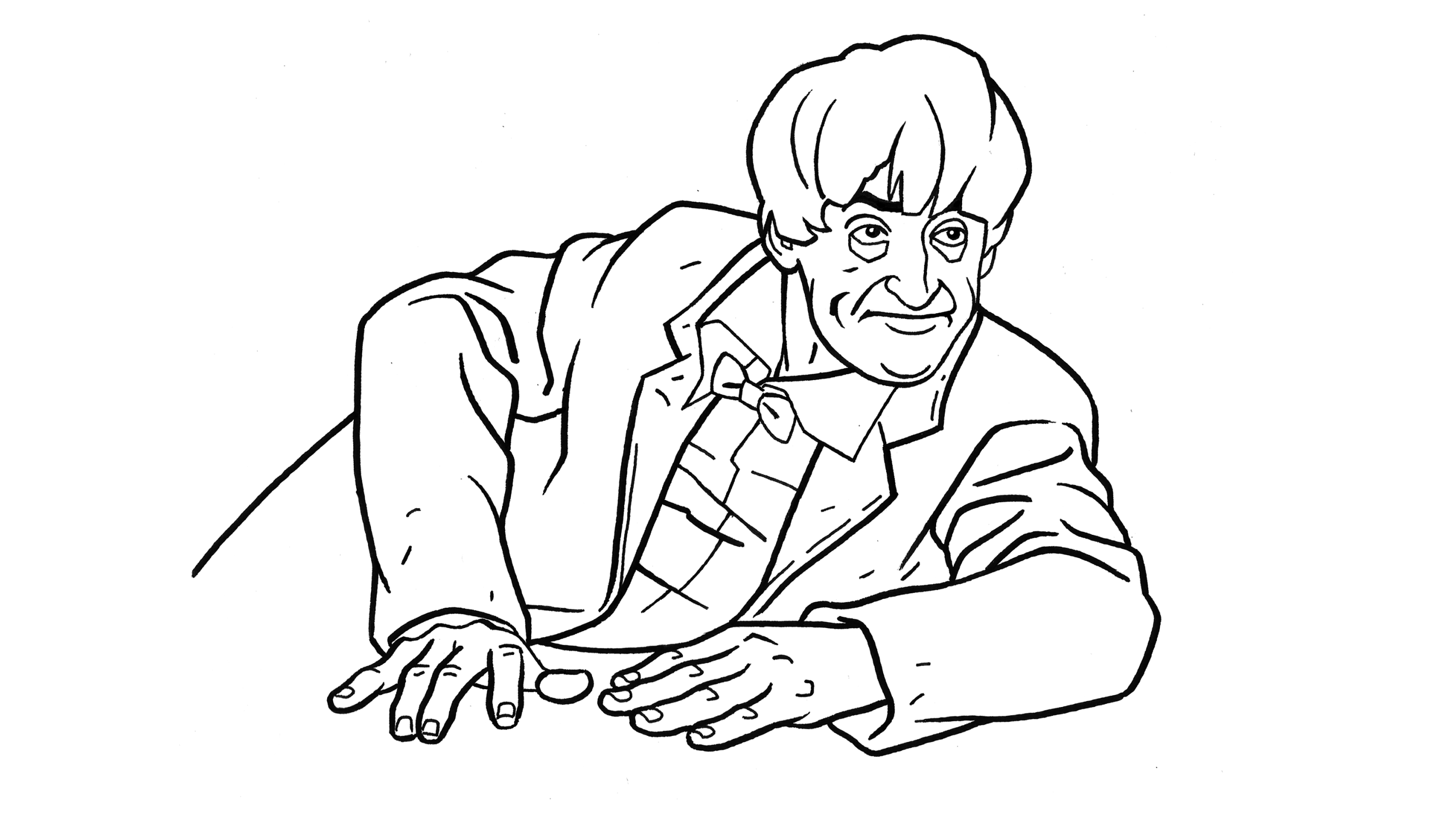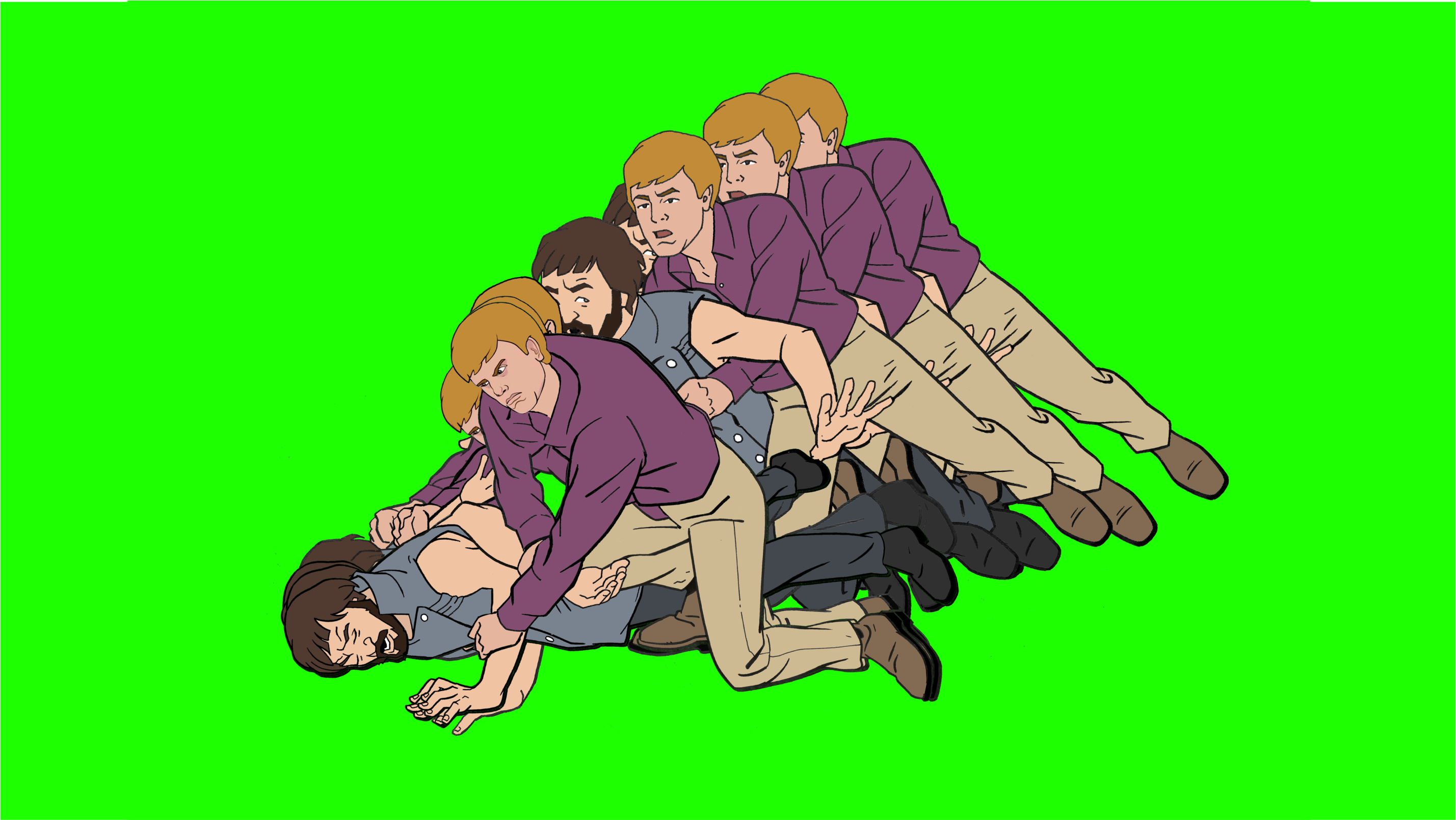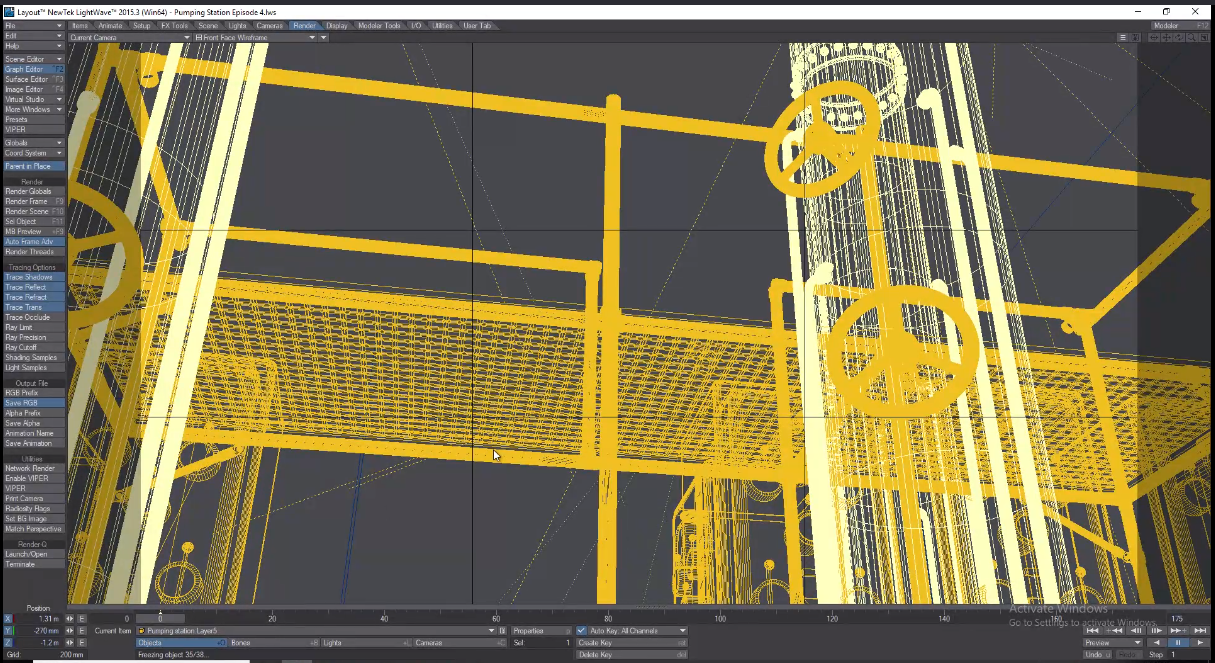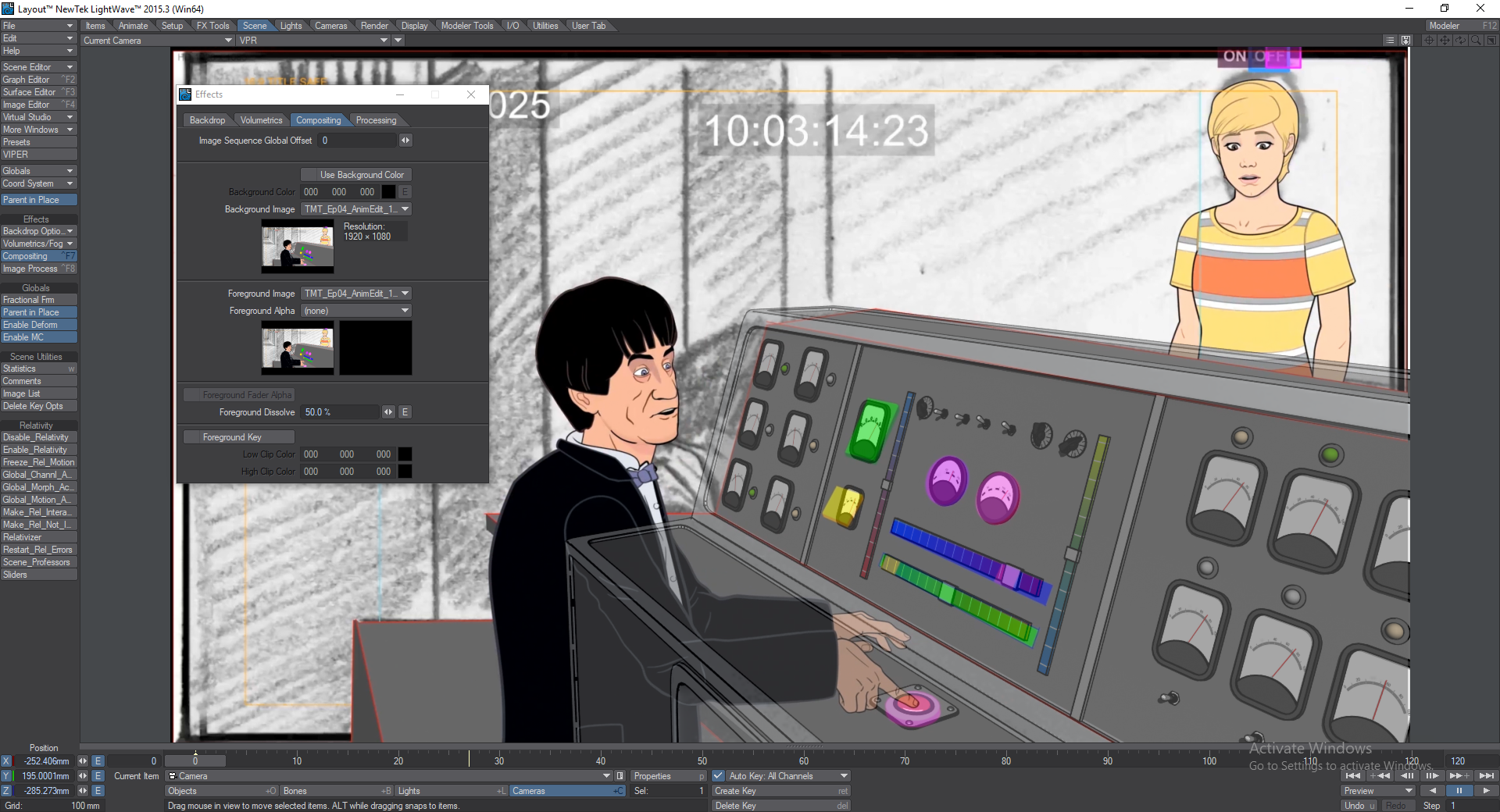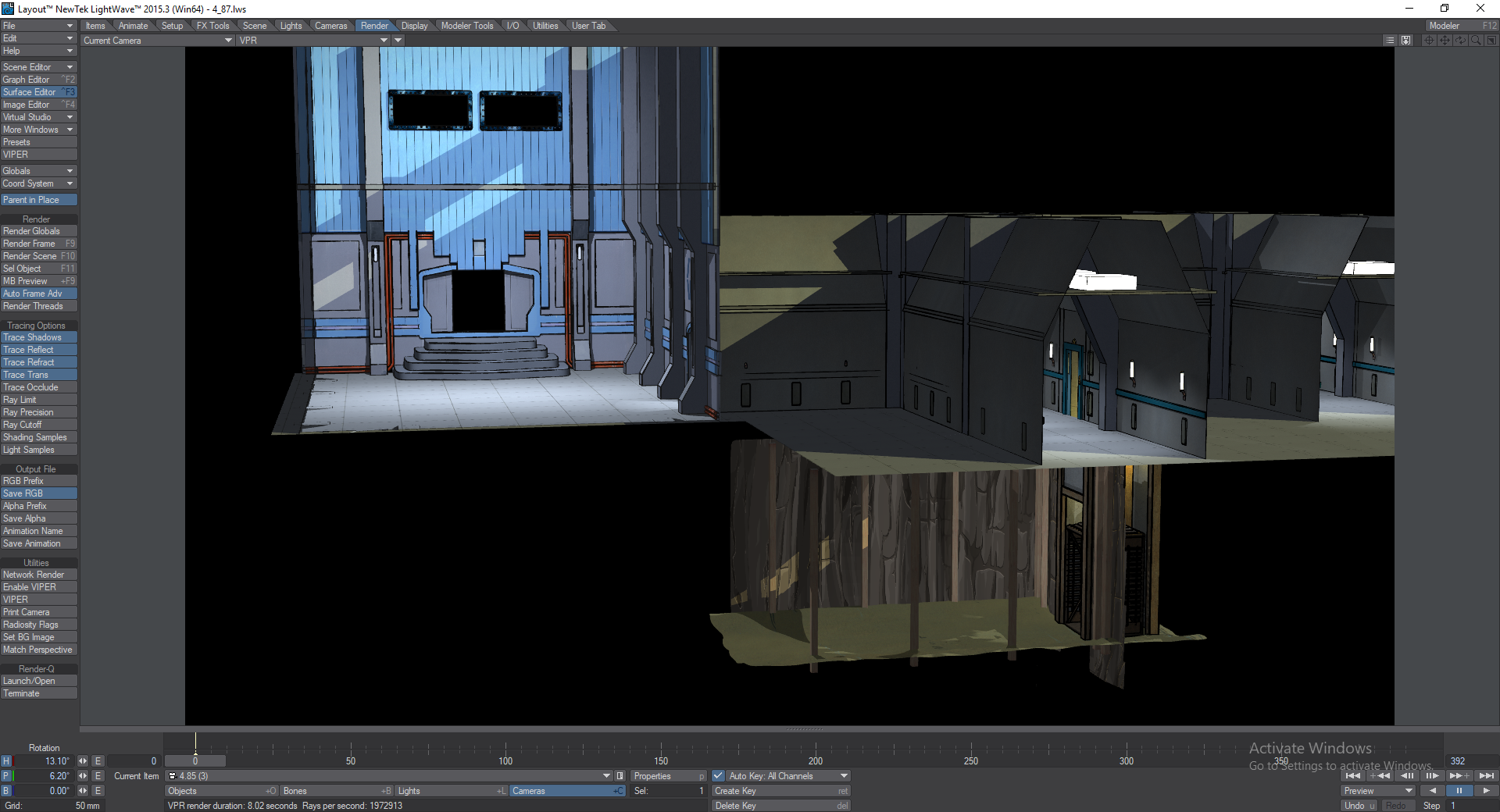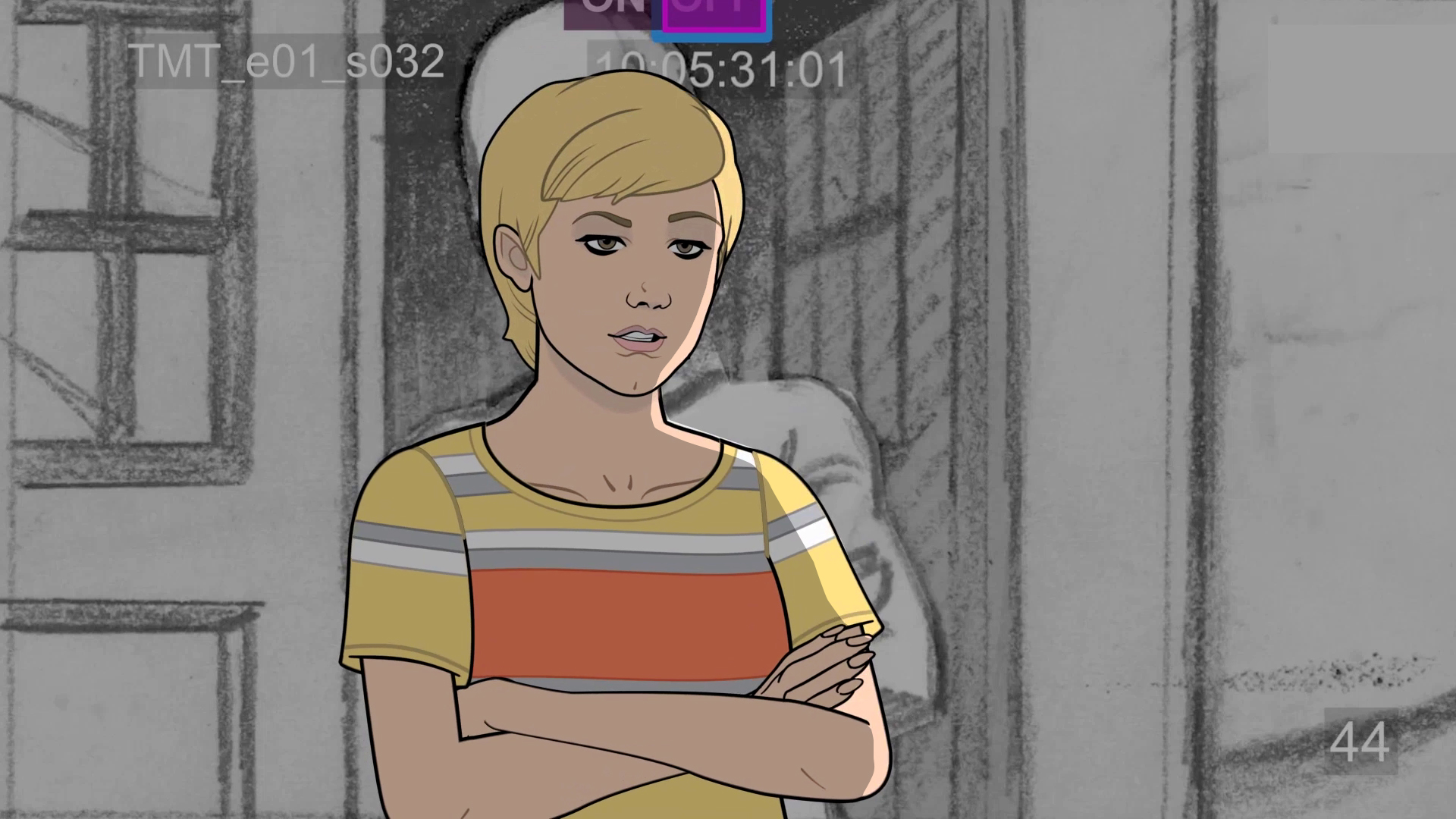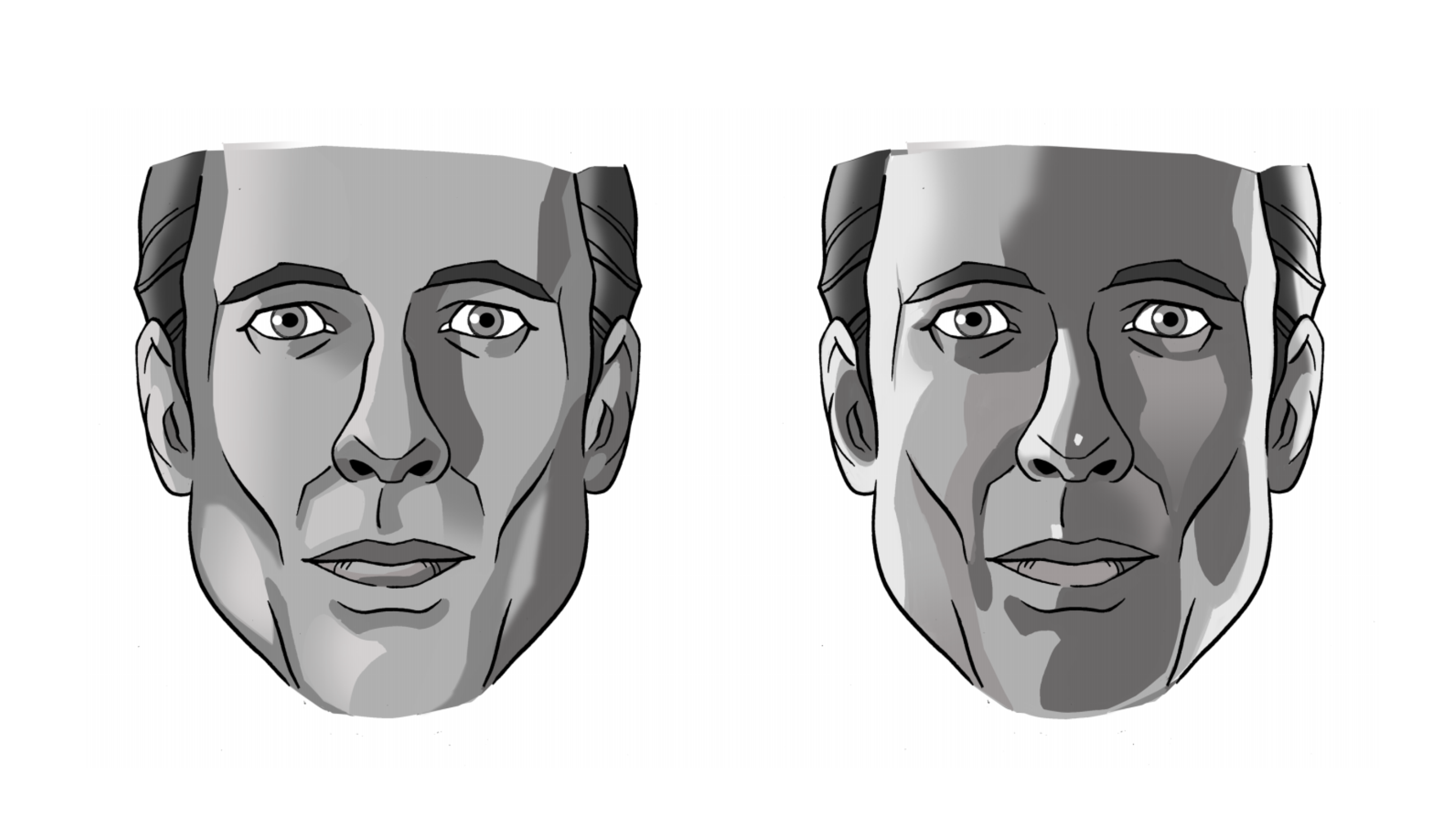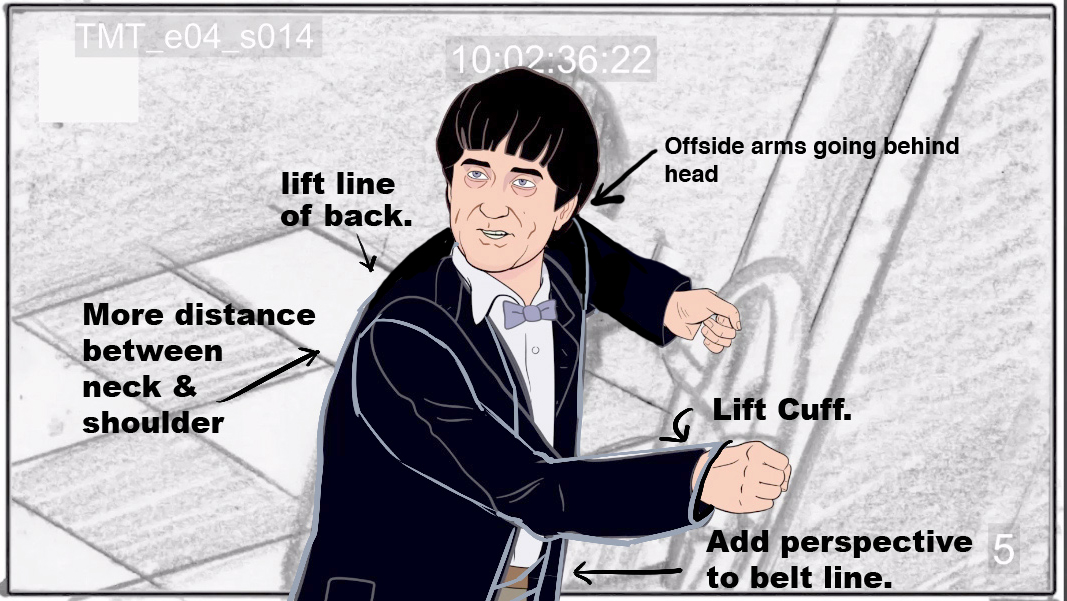
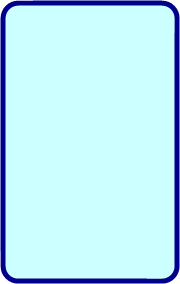
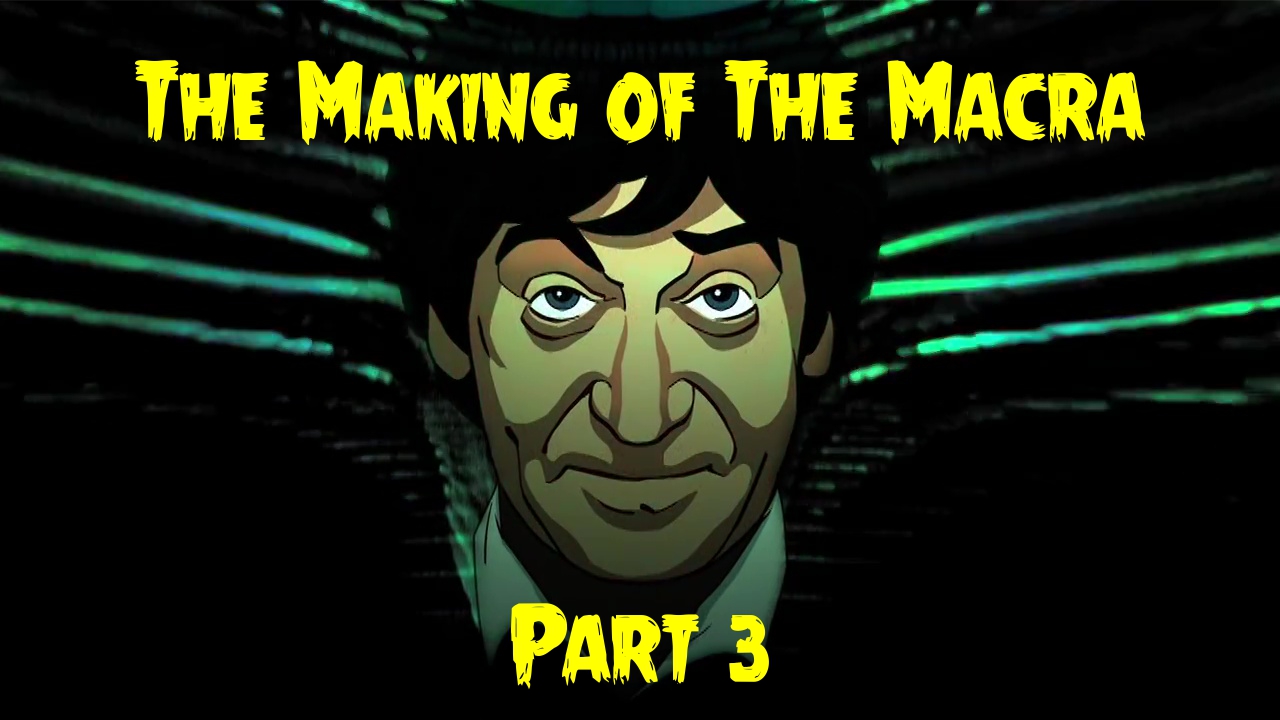
THE MACRA • • • • • • • • • • • • • • •
• MARTIN GERAGHTY:
Early on in the process Charles asked me to redesign the titular Macra, to make them more in keeping with their monstrous crab origins. He quoted the cover of the popular 1970ís Guy N. Smith novel, Night of the Crabs as a potential inspiration.
The Macra had already been re-imagined previously, both on the cover of the Target book novelisation of the 1980s and in the revamped show itself, as the background menace in the 2007 episode, Gridlock. So I felt no concern whatsoever over this act of revision, although I did keep some small aspects of the original design, such as the glowing eyes and the jaw mandibles in particular.
As we were presenting the story in colour and in 16:9 format, the director wanted the Macra to fill the screen and be as wide and menacing as possible, in contrast to the somewhat immobile single prop that the 1967 show had used. Subtly coloured by Adrian and rigged in 3D to move magnificently by Rob, they are one of the triumphs of our take on the story.
• MARTIN GERAGHTY:
Early on in the process Charles asked me to redesign the titular Macra, to make them more in keeping with their monstrous crab origins. He quoted the cover of the popular 1970ís Guy N. Smith novel, Night of the Crabs as a potential inspiration.
The Macra had already been re-imagined previously, both on the cover of the Target book novelisation of the 1980s and in the revamped show itself, as the background menace in the 2007 episode, Gridlock. So I felt no concern whatsoever over this act of revision, although I did keep some small aspects of the original design, such as the glowing eyes and the jaw mandibles in particular.
As we were presenting the story in colour and in 16:9 format, the director wanted the Macra to fill the screen and be as wide and menacing as possible, in contrast to the somewhat immobile single prop that the 1967 show had used. Subtly coloured by Adrian and rigged in 3D to move magnificently by Rob, they are one of the triumphs of our take on the story.

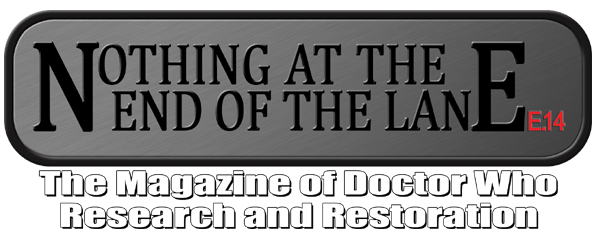
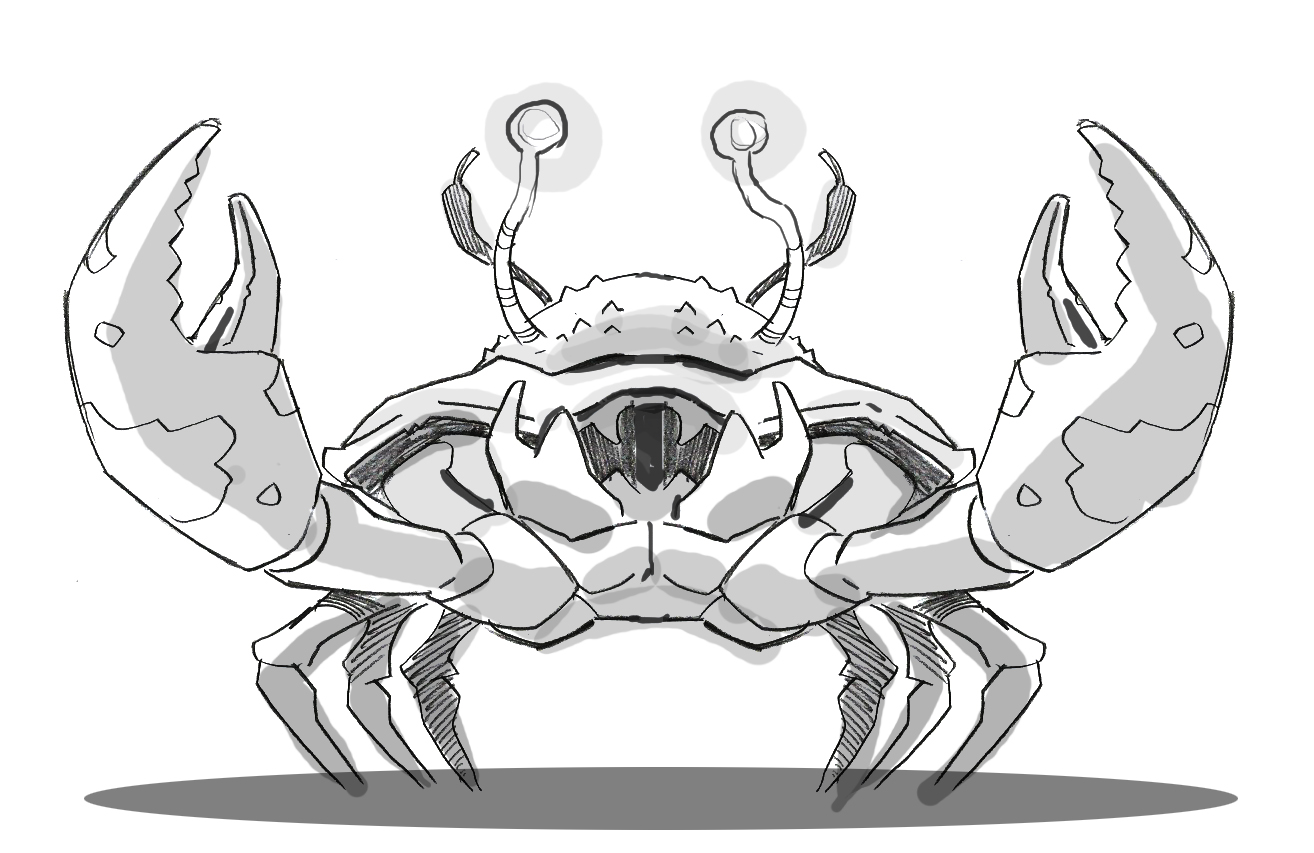

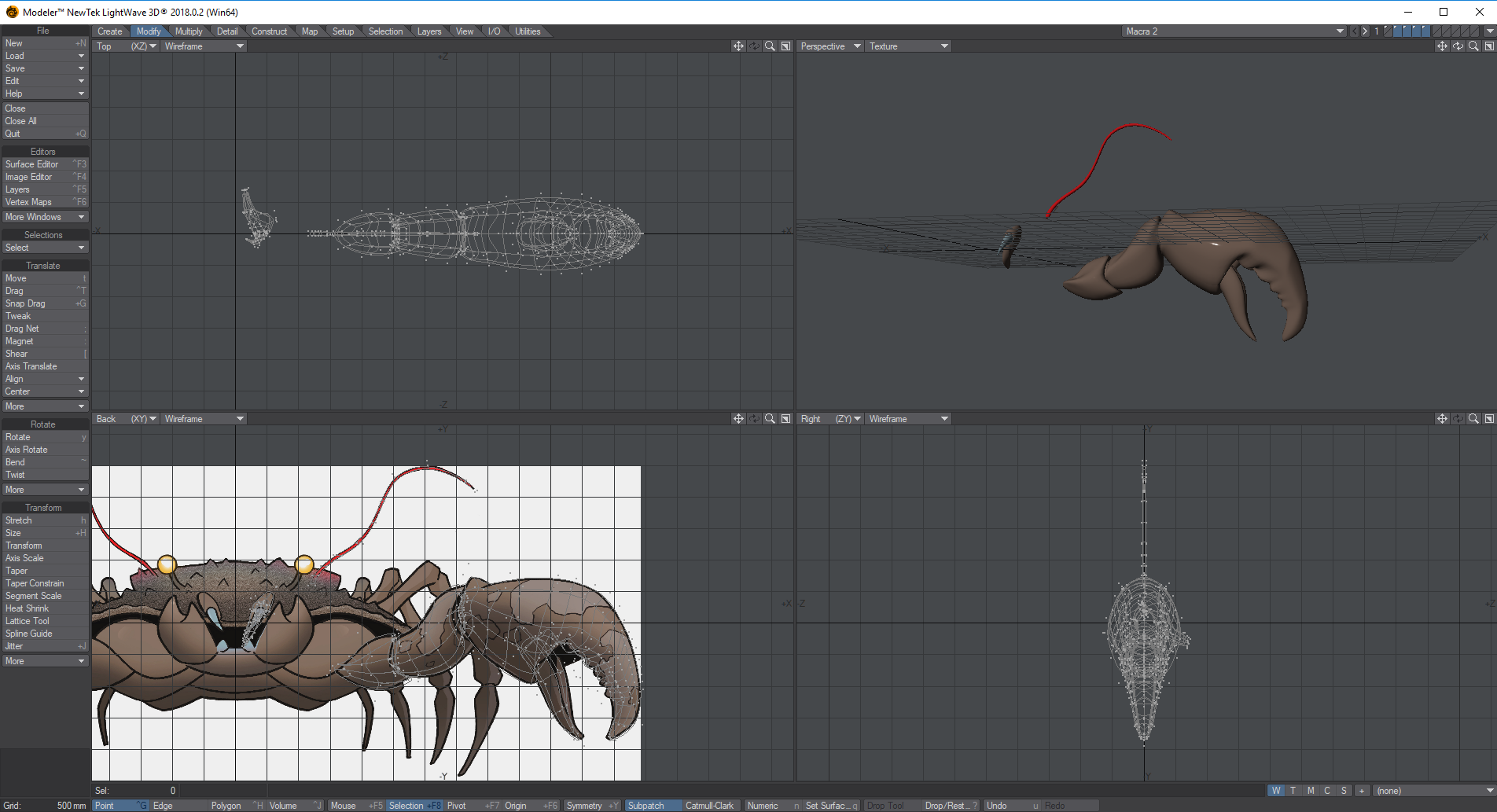
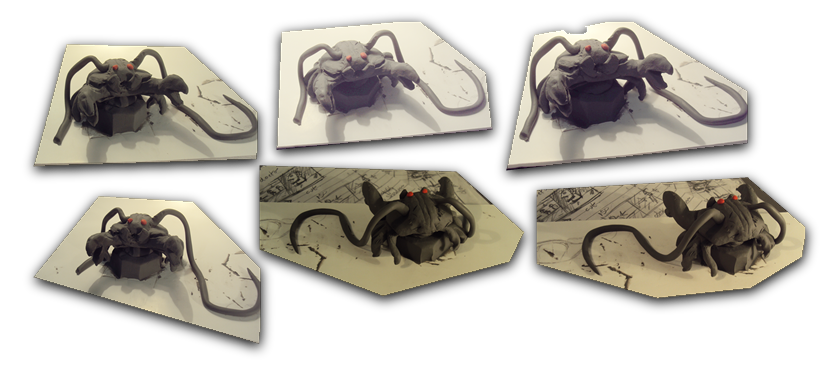
• ROB RITCHIE:
I was pretty excited to have the opportunity to bring the Macra to life for this story. The original prop was a great idea that was let down in its realisation. Charles briefed Martin on his vision of the Macra and he created three views of his Macra design - front, top and side-on - which I would use to trace in Lightwave 3D.
Martin also provided me with a series of carapace patches (drawn in pencil) to map onto the claws that I could use to give each Macra unique markings.
Once the model was built, the next task was to create a bone structure that would be used to move each limb, allowing the model to be animated. A lot of this work was trial and error. I must have gone through a dozen or so different attempts at it before I was happy. Itís one thing to have a drawing on paper, but when you start to move limbs, sometimes the bones can warp the mesh causing bends and folds where there shouldnít be any. I think that, from start to finish, the modelling and rigging of the Macra took about three weeks in total.
I was pretty excited to have the opportunity to bring the Macra to life for this story. The original prop was a great idea that was let down in its realisation. Charles briefed Martin on his vision of the Macra and he created three views of his Macra design - front, top and side-on - which I would use to trace in Lightwave 3D.
Martin also provided me with a series of carapace patches (drawn in pencil) to map onto the claws that I could use to give each Macra unique markings.
Once the model was built, the next task was to create a bone structure that would be used to move each limb, allowing the model to be animated. A lot of this work was trial and error. I must have gone through a dozen or so different attempts at it before I was happy. Itís one thing to have a drawing on paper, but when you start to move limbs, sometimes the bones can warp the mesh causing bends and folds where there shouldnít be any. I think that, from start to finish, the modelling and rigging of the Macra took about three weeks in total.
Adrian Salmon's plasticine concept model for the Macra.
OPENING TITLES • • • • • • • • • • • • • • •
• CHARLES NORTON:
Although the Macra were by far the most complex bits of 3D animation Rob had to produce for the story, it was far from his only job. One of the very first things to be completed for the project in any form was Rob's work on the creation of a new opening title sequence for our programme. The basic plan was to effectively rework the original 1967 Doctor Who title sequence into something that would better fit the new animation. This was less straightforward than it might sound. It was a long process, with Rob and I batting numerous concepts between us from 21st March until the end of June.
The original title sequence was not only in black and white, but was also shaped differently too. In 1967, most TV sets had a much squarer screen than is the norm today. The overall size ratio was usually four units across to three units high. This shape (or aspect ratio) is called 4:3 framing and is very different to the 16:9 (16 units across and nine high) used on modern TVs.
• ROB RITCHIE:
I had already converted the original William Hartnell title sequence into widescreen for The Power of the Daleks. However, this time it would be colourised. The method of turning the original 4:3 sequence into as 16:9 sequence is relatively straight forward and really quick to achieve. It uses a tool in Adobe After Effects called Mesh Warp. You create a grid over an image and you can then warp the image by dragging parts of that grid. The trick is to not warp the Doctor Who logo or the image of Patrick Troughton - only the areas surrounding these elements.
• CHARLES NORTON:
As the project had been commissioned as a specifically colour programme, once the title sequence had been reformatted into the new ratio, the next step was to colour it in. There were a few different ideas kicked around at an early stage, including using a machine-learning program to automatically generate the colours. However, in the end, we decided to look back on the history of Doctor Who itself for some inspiration.
The first all-colour television episode of Doctor Who was filmed in 1969, part of a new era for the programme. However, it also created an unusual problem. The BBC graphics department had always relied upon the electronics of a black and white video camera to create the ethereal animated patterns that made up the Doctor Who title sequence. However, the process didn't really work with any of the BBC's new colour cameras. The solution? The show's graphic designer, Bernard Lodge, simply made the Doctor Who title sequence on black and white film and then tinted and toned the images with a series of abstract colour patterns. Basically, he colourised it.
The obvious idea came to Rob and myself at much the same time. Just take the process that Lodge used in 1969 and apply it to what we had.
• ROB RITCHIE:
I experimented with some colours that were vastly different to the original Pertwee titles sequence, but it didnít seem to be a good fit, so I looked into the colour patterns that were used by Bernard Lodge in 1969 and I thought why not just use those for this sequence? It seemed to give it a strangely familiar yet different look.
• CHARLES NORTON:
Although the Macra were by far the most complex bits of 3D animation Rob had to produce for the story, it was far from his only job. One of the very first things to be completed for the project in any form was Rob's work on the creation of a new opening title sequence for our programme. The basic plan was to effectively rework the original 1967 Doctor Who title sequence into something that would better fit the new animation. This was less straightforward than it might sound. It was a long process, with Rob and I batting numerous concepts between us from 21st March until the end of June.
The original title sequence was not only in black and white, but was also shaped differently too. In 1967, most TV sets had a much squarer screen than is the norm today. The overall size ratio was usually four units across to three units high. This shape (or aspect ratio) is called 4:3 framing and is very different to the 16:9 (16 units across and nine high) used on modern TVs.
• ROB RITCHIE:
I had already converted the original William Hartnell title sequence into widescreen for The Power of the Daleks. However, this time it would be colourised. The method of turning the original 4:3 sequence into as 16:9 sequence is relatively straight forward and really quick to achieve. It uses a tool in Adobe After Effects called Mesh Warp. You create a grid over an image and you can then warp the image by dragging parts of that grid. The trick is to not warp the Doctor Who logo or the image of Patrick Troughton - only the areas surrounding these elements.
• CHARLES NORTON:
As the project had been commissioned as a specifically colour programme, once the title sequence had been reformatted into the new ratio, the next step was to colour it in. There were a few different ideas kicked around at an early stage, including using a machine-learning program to automatically generate the colours. However, in the end, we decided to look back on the history of Doctor Who itself for some inspiration.
The first all-colour television episode of Doctor Who was filmed in 1969, part of a new era for the programme. However, it also created an unusual problem. The BBC graphics department had always relied upon the electronics of a black and white video camera to create the ethereal animated patterns that made up the Doctor Who title sequence. However, the process didn't really work with any of the BBC's new colour cameras. The solution? The show's graphic designer, Bernard Lodge, simply made the Doctor Who title sequence on black and white film and then tinted and toned the images with a series of abstract colour patterns. Basically, he colourised it.
The obvious idea came to Rob and myself at much the same time. Just take the process that Lodge used in 1969 and apply it to what we had.
• ROB RITCHIE:
I experimented with some colours that were vastly different to the original Pertwee titles sequence, but it didnít seem to be a good fit, so I looked into the colour patterns that were used by Bernard Lodge in 1969 and I thought why not just use those for this sequence? It seemed to give it a strangely familiar yet different look.
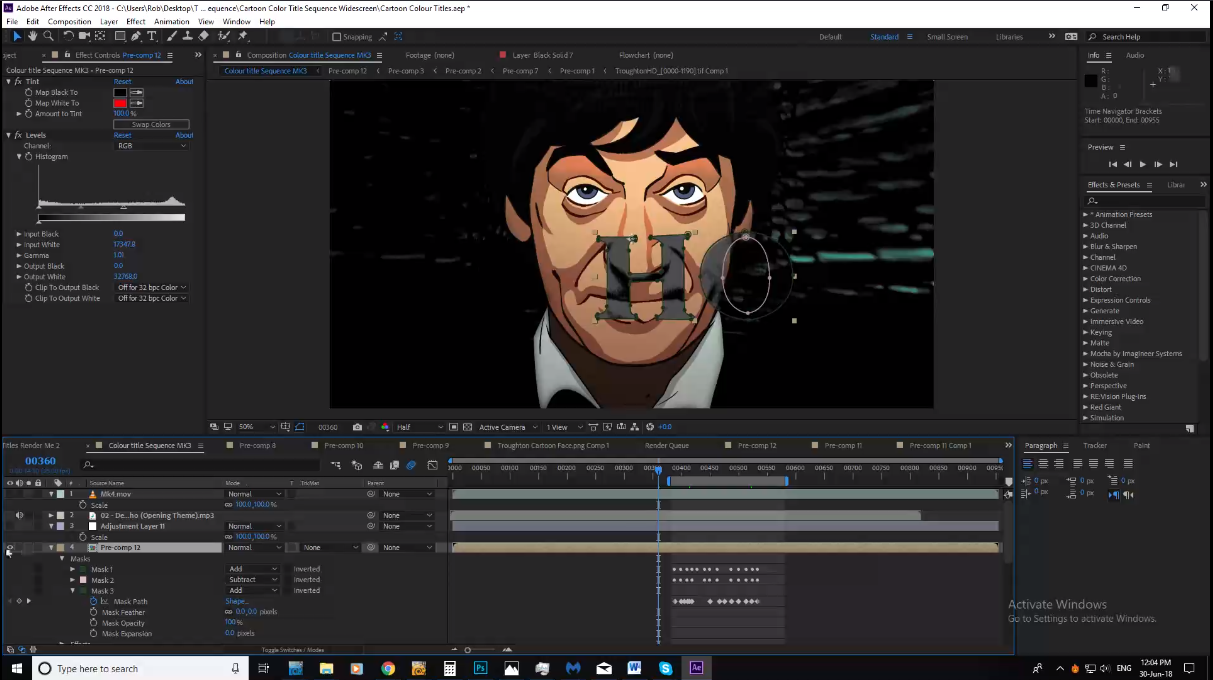
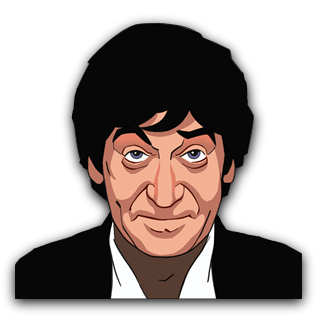
• CHARLES NORTON:
Our resulting title sequence may not have been 100% as it was planned back in 1967, but at least all the colour choices were still those of the original designer. Even with the extended aspect ratio and new colour palette, the titles were still not complete however. There was one more modification to undertake. As fans of the Patrick Troughton era of Doctor Who will know, the 1967 title sequence also featured a photographic image of the lead actor, integrated into Bernard Lodge's footage.
• ROB RITCHIE:
There was some debate about using the original photo of Patrick Troughton or a cartoon version. This had been done before for other animated releases but never used in the final product (Cosgrove Hallís The Invasion had created a cartoon title variant). This time, since the entire story was being animated, it made more sense to me to use a 2D cartoon head, lovingly created by Martin and coloured by Adrian, which fitted perfectly over the original.
Our resulting title sequence may not have been 100% as it was planned back in 1967, but at least all the colour choices were still those of the original designer. Even with the extended aspect ratio and new colour palette, the titles were still not complete however. There was one more modification to undertake. As fans of the Patrick Troughton era of Doctor Who will know, the 1967 title sequence also featured a photographic image of the lead actor, integrated into Bernard Lodge's footage.
• ROB RITCHIE:
There was some debate about using the original photo of Patrick Troughton or a cartoon version. This had been done before for other animated releases but never used in the final product (Cosgrove Hallís The Invasion had created a cartoon title variant). This time, since the entire story was being animated, it made more sense to me to use a 2D cartoon head, lovingly created by Martin and coloured by Adrian, which fitted perfectly over the original.
2D CHARACTER ANIMATION • • • • • • • • • • • • • • •
• CHARLES NORTON:
With a lot of the character work completed, by the end of May there was more than enough material for us to start briefing Sun & Moon Studios on exactly what we wanted for the project. Rigging work on the characters then began.
The initial plan was to use a combination of Adobe Animate as the main animation software program and hand drawn animation, coupled with some 3D, to bring the project to life. This was very much how our first initial animation test scene was completed in March. However, following discussions with Dylan and Louis at the studio in Bristol, it was suggested that we try a software platform called Toom Boom Harmony. This software would mean that would it take considerably longer to rig the characters ready for animation. However, once they were set up in the computer, they'd be much easier to animate and move about. In fact, using Toon Boom's 'master controller' system, it would be possible for the studio to animate the bulk of the programme without needing to do very much actual drawing at all - not once the characters were set up.
I caught the train down to Bristol on 30th May to see how the studio's progress was proceeding on tracing into the program Martin's kit drawings for the Doctor. At the time, the studio was still finishing up work on a CBeebies series called Kit & Pup and were yet to start work in earnest on The Macra Terror. However, early tests importing the Doctor into Toon Boom were extremely promising. The master controller system did have its limitations. If pushed too far, a character could very quickly go 'off-model'. Noses could lose their shape in all sorts of odd ways, for instance. However, the limitations of the new software were massively outweighed by what you gained. It was far easier to achieve extremely fluid body and facial moves in Toon Boom than it ever was in Adobe Animate (or its precursor, Adobe Flash). And so, the decision was made that we would indeed use Toon Boom for the bulk of the 2D character work on the project. As long as we were prepared to dive in and manually redraw certain frames and shots when it broke, it was a program that would work very well indeed.
You can read more about the software and how it was used on The Macra Terror in a blog written by Sun & Moon Studios and available to read on the Toon Boom website:
https://blog.toonboom.com/how-animation-took-doctor-who-the-macra-terror-from-missing-to-magic
The studio began animation work soon after rigging was complete. Shots would be animated in batches. Each batch would be sent over to me on either a Thursday or a Friday. I'd write out my notes, corrections and changes over the weekend and the studio would get to work on those changes the following Monday. Other shots were being animated elsewhere outside of the studio, but the bulk of the character work was done there in Bristol.
Meanwhile, away from the studio, the first of a series of monthly update meetings was held on 4th July at Television Centre. These meetings were all helmed by Paul Hembury and attended by me, Rebecca Richmond (Head of Publishing at BBC Studios), Fiona Ball (Head of Production at BBC Studios) and a roster of other people from BBC Studios who would all be involved in realising the finished DVD and Blu-ray releases and getting them to market in time for the end of March 2019. I was working in New York for a few weeks over the September/October period, so had to join the 26th September meeting and a conference call with Bristol on 23rd October via Skype. However, that aside, the schedule and pattern of production remained largely unchanged until around the end of the year.
The original plan was for all of the studio's elements to be delivered by December 31st 2018. Although, in practical terms, the deadline was a little earlier than that, as the studio intended to shut down over the Christmas period. This would then allow around seven weeks to complete the last parts of compositing, tweak and/or reanimate any parts we weren't happy with and generally get the production ready for release. The episodes were scheduled to be completed in two blocks. First, the animation for Episodes 1 and 4 and then, a few months later, the animation for Episodes 2 and 3. Shots would be delivered to Rob for compositing and effects work via a secure file-sharing platform. They'd go over in batches, staggered over a period of many months, with the last batch coming over (for Episodes 2 and 3) by the close of December. That was the idea anyway. Unfortunately things did not quite go to plan.
Sun & Moon were late delivering and unfortunately they missed their original deadline of 31st December. In fact, although we had most of Episodes 1 and 4 by that date, we had almost no final elements for Episodes 2 and 3 until the middle of January. This had a knock-on effect on how much time there was then left to complete production.
In the end, virtually all of the studio's elements from Episodes 2 and 3 came over together in one big final delivery on 14th January 2019 - around a fortnight later than originally scheduled. This left just over four weeks to complete all of the compositing, corrections and mastering before final delivery in the middle of February. Having worked over Christmas to do as much of the ground work as possible, Rob and I then had to compress an awful lot of work into significantly less time than we'd originally expected.
To add to that workload, some of the shots delivered by Sun & Moon still needed significant and extensive work before they could be locked. And with the studio now having left the production, that work would put a great deal of strain on the core production team of myself, Martin, Adrian and Rob. Things got very intense, very quickly.
AUDIO MASTERING • • • • • • • • • • • • • • •
• CHARLES NORTON:
At least there was one thing we didn't need to worry about. Most of our visual assets were late and in need of further work, but there was no such concern about our audio assets. Mark Ayres had further polished up the audio master for The Macra Terror in the time since production first began. And incorporating all of the small adjustments and cuts made over the course of animation, he'd managed to put together a beautifully crisp final audio mix for our episodes that really tied everything together.
• MARK AYRES:
I was supplied with near-final animation to enable me to re-conform the mastered audio to match the new edit. There were some trims (the infamous rough-and-tumble machine and some short pauses that were perhaps slightly "eggy" in animation) and even some minor extensions where animation could not get the point across as swiftly as a "live" actor.
We also added the prologue and, very occasionally, some subtle additional effects (all period) to help sell an edit or an establishing shot. The final audio masters were rendered at 48kHz, 24-bit and supplied to Rob for compiling with the pictures to form the completed master files for delivery.
COMPOSITING • • • • • • • • • • • • • • •
• CHARLES NORTON:
Rob returned from a holiday on 1st September 2018 and from then on, had to work on The Macra Terror pretty much seven days week, right the way through to the middle of February the following year. It was a very tough few months for all concerned, with far too many all-night sessions.
For Rob in particular, the pressure was especially gruelling. Rob was very much the final link in the chain on The Macra Terror. And so any delays there might be further up stream of him were always going to make life hardest for him most of all. The compositing was completed in a mix of Adobe After Effects and Adobe Premiere, with 3D elements passed through Light Wave. Rob discusses the project in this video:
• CHARLES NORTON:
With a lot of the character work completed, by the end of May there was more than enough material for us to start briefing Sun & Moon Studios on exactly what we wanted for the project. Rigging work on the characters then began.
The initial plan was to use a combination of Adobe Animate as the main animation software program and hand drawn animation, coupled with some 3D, to bring the project to life. This was very much how our first initial animation test scene was completed in March. However, following discussions with Dylan and Louis at the studio in Bristol, it was suggested that we try a software platform called Toom Boom Harmony. This software would mean that would it take considerably longer to rig the characters ready for animation. However, once they were set up in the computer, they'd be much easier to animate and move about. In fact, using Toon Boom's 'master controller' system, it would be possible for the studio to animate the bulk of the programme without needing to do very much actual drawing at all - not once the characters were set up.
I caught the train down to Bristol on 30th May to see how the studio's progress was proceeding on tracing into the program Martin's kit drawings for the Doctor. At the time, the studio was still finishing up work on a CBeebies series called Kit & Pup and were yet to start work in earnest on The Macra Terror. However, early tests importing the Doctor into Toon Boom were extremely promising. The master controller system did have its limitations. If pushed too far, a character could very quickly go 'off-model'. Noses could lose their shape in all sorts of odd ways, for instance. However, the limitations of the new software were massively outweighed by what you gained. It was far easier to achieve extremely fluid body and facial moves in Toon Boom than it ever was in Adobe Animate (or its precursor, Adobe Flash). And so, the decision was made that we would indeed use Toon Boom for the bulk of the 2D character work on the project. As long as we were prepared to dive in and manually redraw certain frames and shots when it broke, it was a program that would work very well indeed.
You can read more about the software and how it was used on The Macra Terror in a blog written by Sun & Moon Studios and available to read on the Toon Boom website:
https://blog.toonboom.com/how-animation-took-doctor-who-the-macra-terror-from-missing-to-magic
The studio began animation work soon after rigging was complete. Shots would be animated in batches. Each batch would be sent over to me on either a Thursday or a Friday. I'd write out my notes, corrections and changes over the weekend and the studio would get to work on those changes the following Monday. Other shots were being animated elsewhere outside of the studio, but the bulk of the character work was done there in Bristol.
Meanwhile, away from the studio, the first of a series of monthly update meetings was held on 4th July at Television Centre. These meetings were all helmed by Paul Hembury and attended by me, Rebecca Richmond (Head of Publishing at BBC Studios), Fiona Ball (Head of Production at BBC Studios) and a roster of other people from BBC Studios who would all be involved in realising the finished DVD and Blu-ray releases and getting them to market in time for the end of March 2019. I was working in New York for a few weeks over the September/October period, so had to join the 26th September meeting and a conference call with Bristol on 23rd October via Skype. However, that aside, the schedule and pattern of production remained largely unchanged until around the end of the year.
The original plan was for all of the studio's elements to be delivered by December 31st 2018. Although, in practical terms, the deadline was a little earlier than that, as the studio intended to shut down over the Christmas period. This would then allow around seven weeks to complete the last parts of compositing, tweak and/or reanimate any parts we weren't happy with and generally get the production ready for release. The episodes were scheduled to be completed in two blocks. First, the animation for Episodes 1 and 4 and then, a few months later, the animation for Episodes 2 and 3. Shots would be delivered to Rob for compositing and effects work via a secure file-sharing platform. They'd go over in batches, staggered over a period of many months, with the last batch coming over (for Episodes 2 and 3) by the close of December. That was the idea anyway. Unfortunately things did not quite go to plan.
Sun & Moon were late delivering and unfortunately they missed their original deadline of 31st December. In fact, although we had most of Episodes 1 and 4 by that date, we had almost no final elements for Episodes 2 and 3 until the middle of January. This had a knock-on effect on how much time there was then left to complete production.
In the end, virtually all of the studio's elements from Episodes 2 and 3 came over together in one big final delivery on 14th January 2019 - around a fortnight later than originally scheduled. This left just over four weeks to complete all of the compositing, corrections and mastering before final delivery in the middle of February. Having worked over Christmas to do as much of the ground work as possible, Rob and I then had to compress an awful lot of work into significantly less time than we'd originally expected.
To add to that workload, some of the shots delivered by Sun & Moon still needed significant and extensive work before they could be locked. And with the studio now having left the production, that work would put a great deal of strain on the core production team of myself, Martin, Adrian and Rob. Things got very intense, very quickly.
AUDIO MASTERING • • • • • • • • • • • • • • •
• CHARLES NORTON:
At least there was one thing we didn't need to worry about. Most of our visual assets were late and in need of further work, but there was no such concern about our audio assets. Mark Ayres had further polished up the audio master for The Macra Terror in the time since production first began. And incorporating all of the small adjustments and cuts made over the course of animation, he'd managed to put together a beautifully crisp final audio mix for our episodes that really tied everything together.
• MARK AYRES:
I was supplied with near-final animation to enable me to re-conform the mastered audio to match the new edit. There were some trims (the infamous rough-and-tumble machine and some short pauses that were perhaps slightly "eggy" in animation) and even some minor extensions where animation could not get the point across as swiftly as a "live" actor.
We also added the prologue and, very occasionally, some subtle additional effects (all period) to help sell an edit or an establishing shot. The final audio masters were rendered at 48kHz, 24-bit and supplied to Rob for compiling with the pictures to form the completed master files for delivery.
COMPOSITING • • • • • • • • • • • • • • •
• CHARLES NORTON:
Rob returned from a holiday on 1st September 2018 and from then on, had to work on The Macra Terror pretty much seven days week, right the way through to the middle of February the following year. It was a very tough few months for all concerned, with far too many all-night sessions.
For Rob in particular, the pressure was especially gruelling. Rob was very much the final link in the chain on The Macra Terror. And so any delays there might be further up stream of him were always going to make life hardest for him most of all. The compositing was completed in a mix of Adobe After Effects and Adobe Premiere, with 3D elements passed through Light Wave. Rob discusses the project in this video:
RE-ANIMATION AND FIXES • • • • • • • • • • • • • • •
• CHARLES NORTON:
As mentioned above, although we were very pleased with the fluidity of movement on the character shots achieved by the new Toon Boom software, there were nonetheless a lot of things that still needed fixing. Some were very minor issues, others were more serious.
Using the software's master controllers, you could move the characters about with great ease and fluidity. However, regardless of how it might look, it is not true 3D animation. You're not actually working with a 3D object. It's really just a trick of the software that makes it look like that. It's a really clever trick. Staggeringly clever. However, it's still a trick. And as with any trick, if you push it too far, you start to see the flaws in it.
You could get the Doctor to turn his head maybe 30-degrees from one side to the other and it would look fine, but as soon as he looks over his shoulder, the kit begins to let you down, as the software tries to make sense of what you're getting it to do. The nose stops looking like his nose, the ear moves oddly and before very long, the Doctor simply doesn't look like the Doctor anymore. It was an even bigger problem with Ben and Polly, who in all honesty, just never really looked like who they were supposed to. The studio had, understandably, simplified some of Martin's line-work to make it work best for them, but ultimately that really just made the problem worse. The only real answer was to go in and re-draw individual frames by hand for those sections where things went badly wrong. Unfortunately, the studio didn't always feel able to do that. And by the final quarter of 2018, we already had an extremely long list of shots that needed re-drawing or in some other way adjusting.
And it all had to be done manually, of course. The old fashioned way, going frame-by-frame. On the upside, we normally had the studio's first pass at a shot to work from. This massively saved on time. We could often retain all the lip-sync in a shot from the studio's work and then only need to redraw the body of a character, or maybe just their arm from scratch. You can see some examples of the fixes we did in the images accompanying this article. Key to most of these fixes was the near limitless patience and perseverance of Adrian Salmon, who rejoined us on the show toward the end of 2018 to help us with the additional work.
• CHARLES NORTON:
As mentioned above, although we were very pleased with the fluidity of movement on the character shots achieved by the new Toon Boom software, there were nonetheless a lot of things that still needed fixing. Some were very minor issues, others were more serious.
Using the software's master controllers, you could move the characters about with great ease and fluidity. However, regardless of how it might look, it is not true 3D animation. You're not actually working with a 3D object. It's really just a trick of the software that makes it look like that. It's a really clever trick. Staggeringly clever. However, it's still a trick. And as with any trick, if you push it too far, you start to see the flaws in it.
You could get the Doctor to turn his head maybe 30-degrees from one side to the other and it would look fine, but as soon as he looks over his shoulder, the kit begins to let you down, as the software tries to make sense of what you're getting it to do. The nose stops looking like his nose, the ear moves oddly and before very long, the Doctor simply doesn't look like the Doctor anymore. It was an even bigger problem with Ben and Polly, who in all honesty, just never really looked like who they were supposed to. The studio had, understandably, simplified some of Martin's line-work to make it work best for them, but ultimately that really just made the problem worse. The only real answer was to go in and re-draw individual frames by hand for those sections where things went badly wrong. Unfortunately, the studio didn't always feel able to do that. And by the final quarter of 2018, we already had an extremely long list of shots that needed re-drawing or in some other way adjusting.
And it all had to be done manually, of course. The old fashioned way, going frame-by-frame. On the upside, we normally had the studio's first pass at a shot to work from. This massively saved on time. We could often retain all the lip-sync in a shot from the studio's work and then only need to redraw the body of a character, or maybe just their arm from scratch. You can see some examples of the fixes we did in the images accompanying this article. Key to most of these fixes was the near limitless patience and perseverance of Adrian Salmon, who rejoined us on the show toward the end of 2018 to help us with the additional work.
• ADRIAN SALMON:
In November I was rehired to work for approximately six weeks on additional character shading and revisions. We'd been under the impression that we'd be receiving fully shaded 2D figure animations, so when the PNG frames started arriving with only simple embedded structural shades, it was decided that we should go ahead and shade up certain shots to enhance the artwork.
Previously I'd worked on The Power of the Daleks and Shada in this capacity. My first job was to add shading to the black and white pre-title-sequence, set in the TARDIS control room. The character animation frames were created in colour, so had to be converted to greyscale first. This presented another problem in that when the colours where changed to black and white, their values lost contrast. Polly's shirt and skin became a single tone, so I had to then adjust the greyscale tonal range to better distinguish the textures in black and white. I added light source shadings to the Doctor, Jamie and Polly, but Ben was left intact. The work added a lot of depth to the characters. Polly also required a painstaking frame by frame correction of her eyes and nose, which had gone considerably off-model.
My next assignment was to create the illusion that the Doctor was coming out of the shadows when he finds Medok hiding in an old abandoned building. The studio's PNG sequence of the Doctor moving forward was fine, but there was no sense he was emerging from the darkness because the artwork was essentially flat. After looking at a number of film noir lighting effects, I individually shaded each frame, but started with his face in mid reveal and then moved forward and backward through the frames until I'd got the result we wanted. This was dropped into Photoshop Time Line and a basic MP4 video was rendered and sent for approval.
Revisions of the Doctor's shoulders unfortunately formed the larger part of my work. The Toon Boom technology had trouble with this aspect of the figure and I spent many hours at the drawing board with print offs, redrawing more realistic shoulders/torsos and importing them back into the frames. There's a lovely bit of animation where we see the Doctor from Officia's point-of-view, looking down at Patrick who is turning a large gas pipe wheel. Whilst the shot only needed a little shading to bed it in, the shoulders were very distracting. Frame by frame, I used four different shoulder positional drawings to correct the figure work. The same thing happened with the Doctor writing on the see-through plastic board. The majority of his shoulders were fine, but there was a sequence of 250 frames that each needed revision. The fault marred some otherwise superb character animation and since this was my episode, I determined to fix this at all costs! When Toon Boom works, it works VERY well, but when it doesn't, a human hand is really needed, to draw things in traditionally.
Other than drawing revisions, another large part of my work was the shading of various animation elements drawn by Martin. These elements are standalone drawings that aren't featured in the moving animation sections. An example is the long artwork of the crowds we pan over as Medok is escorted by Ola and his guards to prison. I downloaded the fully inked artwork and added a base colour first before a general shade set to multiply over the scene. This helps harmonise the colour palette, so the drawings become more than 2D representations and add some depth to the scene. Unfortunately another element shot of Medok hiding behind a sand hill didn't end up being used, because the when the animation frames came back from the studio, we couldn't sync it with his movements successfully. It finally ended up on the DVD extras, which was a bit of a shame.
One of the earliest elements I shaded was the face of the controller, seen on the ubiquitous screens dotted around the colony. Initially I planned only to do one version of this, the more benign look of the face that we see on the tele-snaps, but on a whim I did a darker, more intense variation. This was used as the story progressively became more oppressive, to match the darker mood. At the same time I was also asked to colour the artwork of Patrick Troughton to be used on the title sequence. It had been decided to use a drawing rather than a photograph because this was an animation after all. Using a screen-grab as reference I tried to replicate the same lighting, albeit simpler and with a harder edge to the shadows - two versions of which were sent to my 'controller'. When messing about with the colour, I had inadvertently created a subtle red tint above his eyes that immediately brought his face to life - happy accidents are an artist's best friend.
In November I was rehired to work for approximately six weeks on additional character shading and revisions. We'd been under the impression that we'd be receiving fully shaded 2D figure animations, so when the PNG frames started arriving with only simple embedded structural shades, it was decided that we should go ahead and shade up certain shots to enhance the artwork.
Previously I'd worked on The Power of the Daleks and Shada in this capacity. My first job was to add shading to the black and white pre-title-sequence, set in the TARDIS control room. The character animation frames were created in colour, so had to be converted to greyscale first. This presented another problem in that when the colours where changed to black and white, their values lost contrast. Polly's shirt and skin became a single tone, so I had to then adjust the greyscale tonal range to better distinguish the textures in black and white. I added light source shadings to the Doctor, Jamie and Polly, but Ben was left intact. The work added a lot of depth to the characters. Polly also required a painstaking frame by frame correction of her eyes and nose, which had gone considerably off-model.
My next assignment was to create the illusion that the Doctor was coming out of the shadows when he finds Medok hiding in an old abandoned building. The studio's PNG sequence of the Doctor moving forward was fine, but there was no sense he was emerging from the darkness because the artwork was essentially flat. After looking at a number of film noir lighting effects, I individually shaded each frame, but started with his face in mid reveal and then moved forward and backward through the frames until I'd got the result we wanted. This was dropped into Photoshop Time Line and a basic MP4 video was rendered and sent for approval.
Revisions of the Doctor's shoulders unfortunately formed the larger part of my work. The Toon Boom technology had trouble with this aspect of the figure and I spent many hours at the drawing board with print offs, redrawing more realistic shoulders/torsos and importing them back into the frames. There's a lovely bit of animation where we see the Doctor from Officia's point-of-view, looking down at Patrick who is turning a large gas pipe wheel. Whilst the shot only needed a little shading to bed it in, the shoulders were very distracting. Frame by frame, I used four different shoulder positional drawings to correct the figure work. The same thing happened with the Doctor writing on the see-through plastic board. The majority of his shoulders were fine, but there was a sequence of 250 frames that each needed revision. The fault marred some otherwise superb character animation and since this was my episode, I determined to fix this at all costs! When Toon Boom works, it works VERY well, but when it doesn't, a human hand is really needed, to draw things in traditionally.
Other than drawing revisions, another large part of my work was the shading of various animation elements drawn by Martin. These elements are standalone drawings that aren't featured in the moving animation sections. An example is the long artwork of the crowds we pan over as Medok is escorted by Ola and his guards to prison. I downloaded the fully inked artwork and added a base colour first before a general shade set to multiply over the scene. This helps harmonise the colour palette, so the drawings become more than 2D representations and add some depth to the scene. Unfortunately another element shot of Medok hiding behind a sand hill didn't end up being used, because the when the animation frames came back from the studio, we couldn't sync it with his movements successfully. It finally ended up on the DVD extras, which was a bit of a shame.
One of the earliest elements I shaded was the face of the controller, seen on the ubiquitous screens dotted around the colony. Initially I planned only to do one version of this, the more benign look of the face that we see on the tele-snaps, but on a whim I did a darker, more intense variation. This was used as the story progressively became more oppressive, to match the darker mood. At the same time I was also asked to colour the artwork of Patrick Troughton to be used on the title sequence. It had been decided to use a drawing rather than a photograph because this was an animation after all. Using a screen-grab as reference I tried to replicate the same lighting, albeit simpler and with a harder edge to the shadows - two versions of which were sent to my 'controller'. When messing about with the colour, I had inadvertently created a subtle red tint above his eyes that immediately brought his face to life - happy accidents are an artist's best friend.
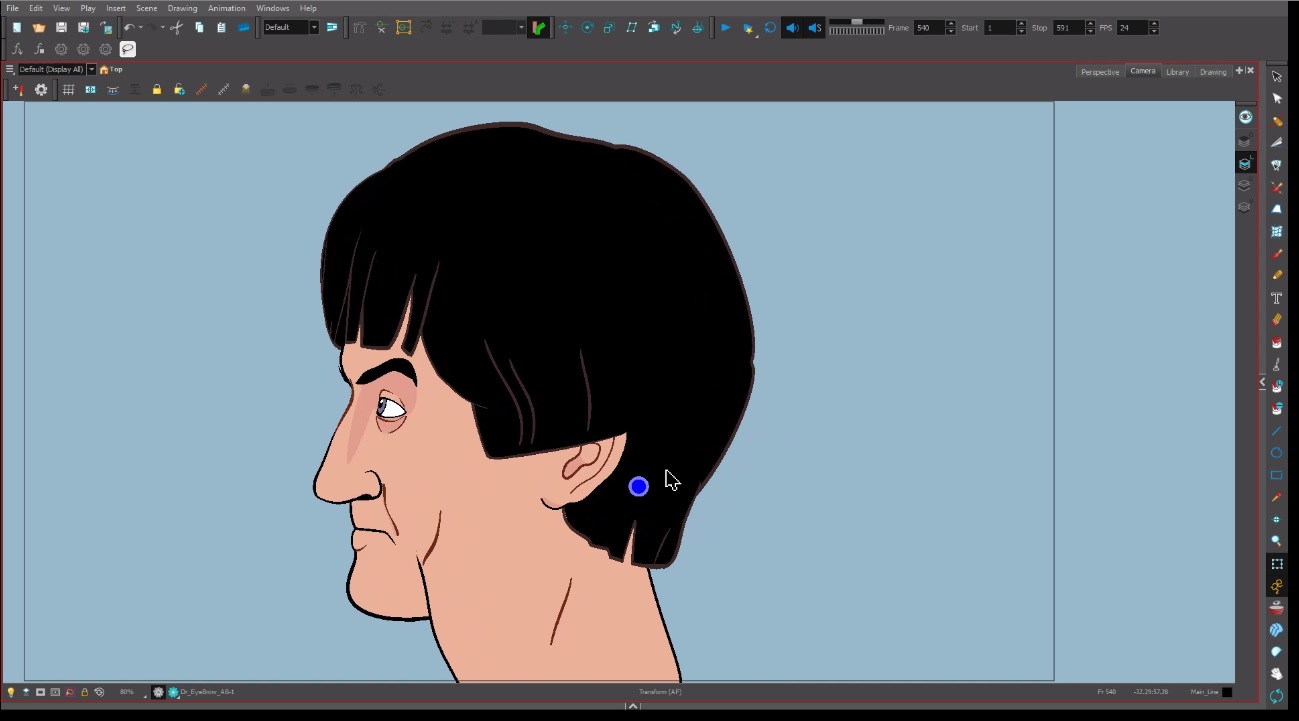
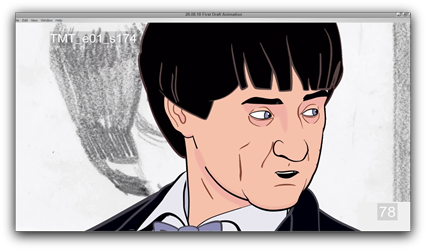
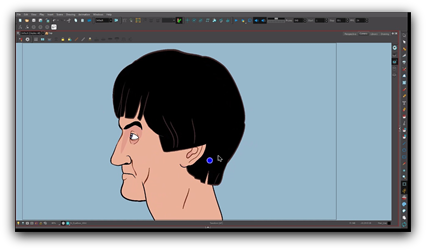
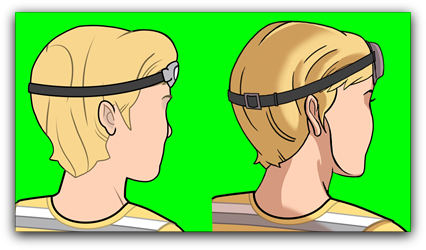
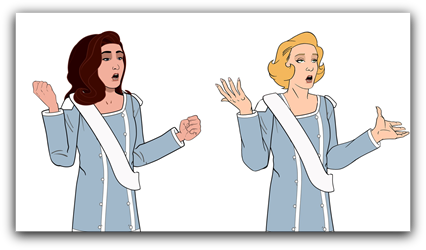
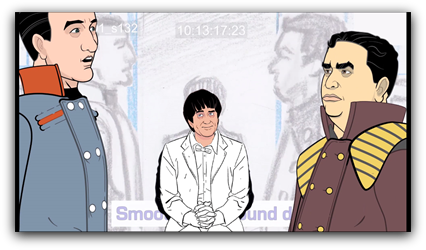
One of the shots we were most proud of developing occurs in Episode 4. Shot 4.203, to be precise. The Doctor has just proved to Pilot the existence of the Macra and the Pilot slumps down a wall, dejected and in total shock. It was to be a completely static shot with only Pilot talking and the Doctor looking down on him. However, when the 2D animation returned, not only was Pilot visibly twitching and needlessly 'acting', but the drawing of him slumped needed a complete redraw. We decided the easiest fix was to use Martin's original layout drawing (that had been sent to the studio as a guide), but now coloured up by me and dropped onto each frame individually, leaving only the animation of Pilot's head talking remaining from the studio's raw original. This was slow and meticulous work, made easier only by the collar on the Pilot's uniform giving us a clean edge to work up to. However, eventually once composited, this shot turned out pretty much as we'd hoped.
Eventually time and money simply ran out for us to improve all the things we might have wanted to, but we'd made significant ground and many scenes we planned as highlights still retain their original vision.
Eventually time and money simply ran out for us to improve all the things we might have wanted to, but we'd made significant ground and many scenes we planned as highlights still retain their original vision.
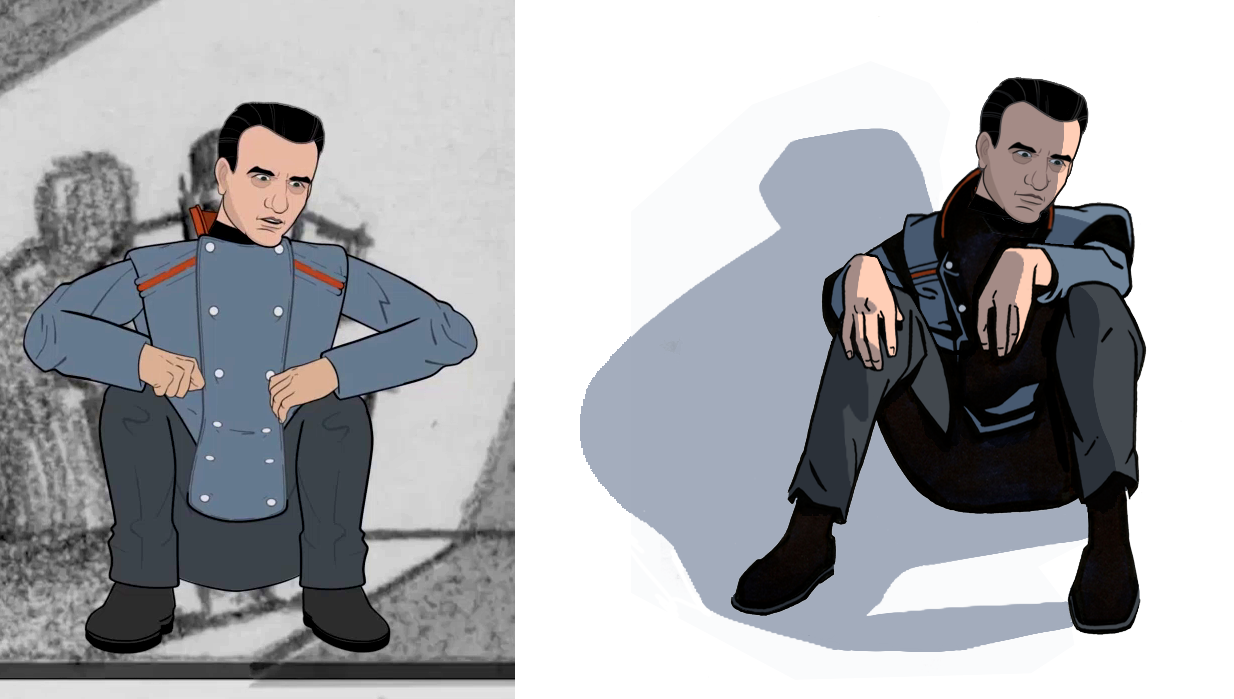
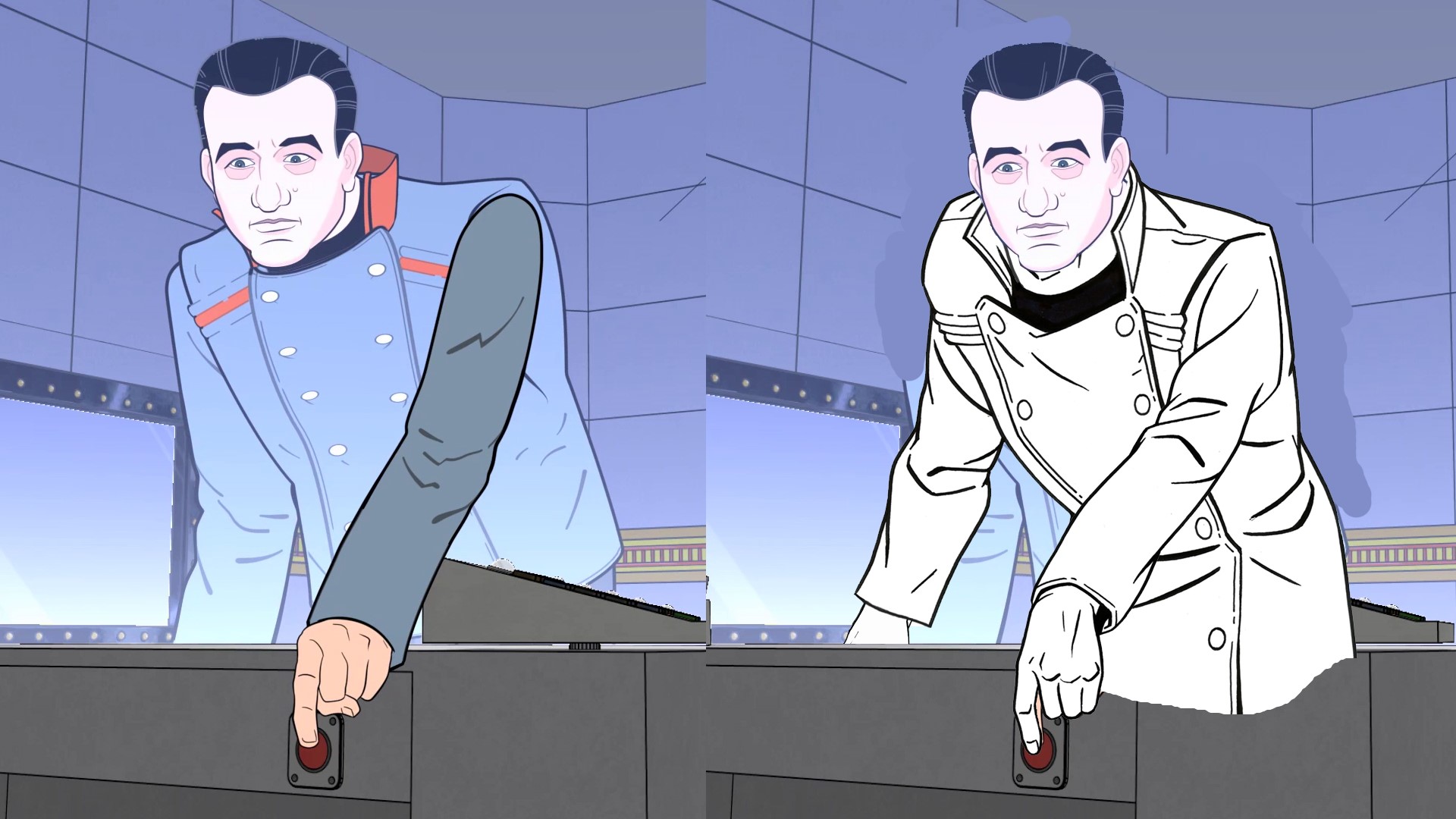
• CHARLES NORTON:
Of course, a huge factor in us being able to make our shots work, was the fact that we had such an incredibly strong lead figurative artist on board, in the form of Martin Geraghty. It may have taken Adrian and myself many, many, many hours and days and weeks of our lives to go through the shots replacing body parts and heads. However, it was only really possible because we had such wonderful artwork from Martin to use.
Martin's contract formally came to an end on 1st October. However, we then wound up bringing him back a few times, with him actually completing his last work for us in early February 2019. Had we not re-hired him, I don't know how we would have ever completed all the work we did.
Martin will tell you that he just did a few touch-ups on static pencil drawings here and there. However, it's not true. Martin did significantly more than that. There were a small number of shots (and it was only a small number, admittedly) where the elements we had delivered from the studio simply weren't usable at all.
When that happened you just had to animate the sequence from scratch. For example, there's one shot in the first episode where some typists stop work to look up at a screen. That was animated by Martin - all done in pencil on paper. Most of the cheerleader dancing was done that way too. It was a mammoth undertaking and it is a huge testament to everyone involved that it was done as proficiently as it was.
And incidentally, before I forget, that glob of green goo that drips from the ceiling in Episode 3 and lands on Jamie's back. I animated that. All traditionally animated into the early hours of one long weekend. I'm rather proud of that goo.
Of course, a huge factor in us being able to make our shots work, was the fact that we had such an incredibly strong lead figurative artist on board, in the form of Martin Geraghty. It may have taken Adrian and myself many, many, many hours and days and weeks of our lives to go through the shots replacing body parts and heads. However, it was only really possible because we had such wonderful artwork from Martin to use.
Martin's contract formally came to an end on 1st October. However, we then wound up bringing him back a few times, with him actually completing his last work for us in early February 2019. Had we not re-hired him, I don't know how we would have ever completed all the work we did.
Martin will tell you that he just did a few touch-ups on static pencil drawings here and there. However, it's not true. Martin did significantly more than that. There were a small number of shots (and it was only a small number, admittedly) where the elements we had delivered from the studio simply weren't usable at all.
When that happened you just had to animate the sequence from scratch. For example, there's one shot in the first episode where some typists stop work to look up at a screen. That was animated by Martin - all done in pencil on paper. Most of the cheerleader dancing was done that way too. It was a mammoth undertaking and it is a huge testament to everyone involved that it was done as proficiently as it was.
And incidentally, before I forget, that glob of green goo that drips from the ceiling in Episode 3 and lands on Jamie's back. I animated that. All traditionally animated into the early hours of one long weekend. I'm rather proud of that goo.
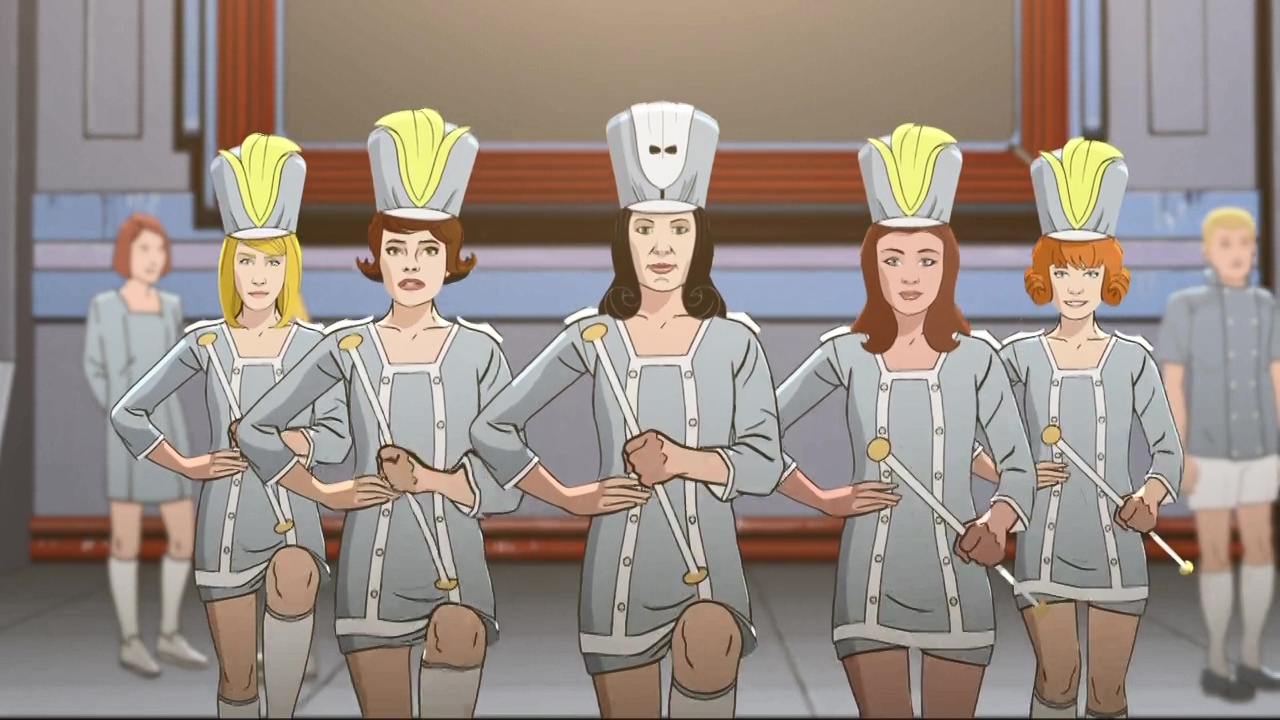
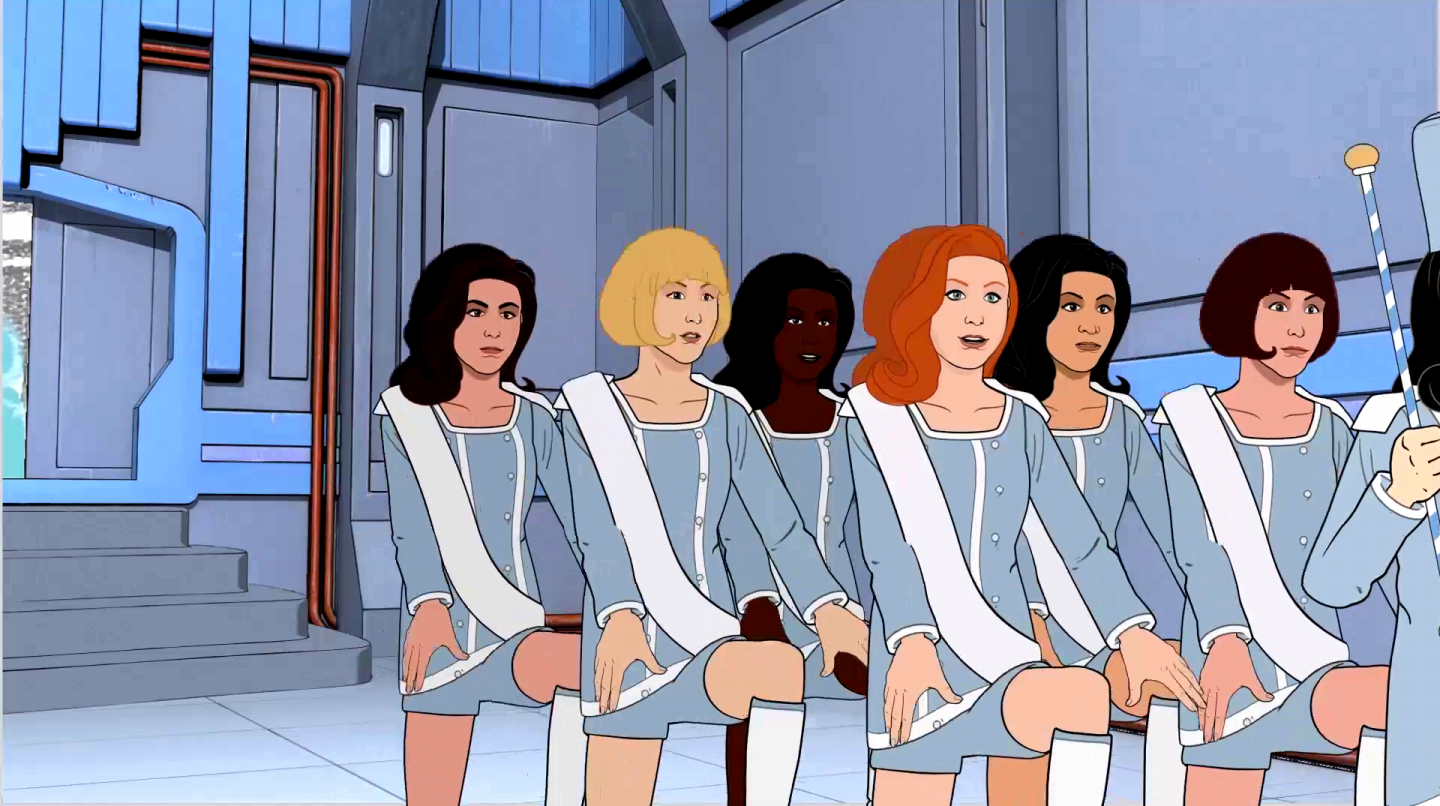
With everyone working flat-out, as we approached Christmas, I also brought in another pair of hands to help us over the finish-line.
David Busch is an animator and compositor based in Iowa. He used to work for Dreamworks on some of their animated features and also worked with Marvel on their Black Panther animated series. More to the point, he's also a huge Doctor Who fan. He'd helped us in 2017 when we were working through the last stages of production on Shada and his dedication and talent has always made him an extremely useful chap to have around.
David Busch is an animator and compositor based in Iowa. He used to work for Dreamworks on some of their animated features and also worked with Marvel on their Black Panther animated series. More to the point, he's also a huge Doctor Who fan. He'd helped us in 2017 when we were working through the last stages of production on Shada and his dedication and talent has always made him an extremely useful chap to have around.
• DAVID BUSCH:
Charles contacted me when he was working on the animation for Shada, and upon my completion of a brief test scene, he invited me to be a part of the production. My role on Shada was adding lighting and shadows to the character animation, and I worked on the project for about 20 weeks during the summer and autumn of 2017. It was a lot of hard work, but an amazing experience overall - and the thrill of seeing my name in the credits of a Tom Baker story was one of the highlights of my professional career!
Naturally, I was delighted when Charles called me again toward the end of 2018, and asked if I might have some free time coming up to help out with The Macra Terror. This project was pretty far along in its production schedule when I was brought onboard, and my job on this one was mainly to help with a variety of animation revisions and to add some shading to a key sequence. The character design for The Macra Terror was done by the amazing Martin Geraghty and he had provided designs for various background characters to Sun & Moon. However,
Charles contacted me when he was working on the animation for Shada, and upon my completion of a brief test scene, he invited me to be a part of the production. My role on Shada was adding lighting and shadows to the character animation, and I worked on the project for about 20 weeks during the summer and autumn of 2017. It was a lot of hard work, but an amazing experience overall - and the thrill of seeing my name in the credits of a Tom Baker story was one of the highlights of my professional career!
Naturally, I was delighted when Charles called me again toward the end of 2018, and asked if I might have some free time coming up to help out with The Macra Terror. This project was pretty far along in its production schedule when I was brought onboard, and my job on this one was mainly to help with a variety of animation revisions and to add some shading to a key sequence. The character design for The Macra Terror was done by the amazing Martin Geraghty and he had provided designs for various background characters to Sun & Moon. However,
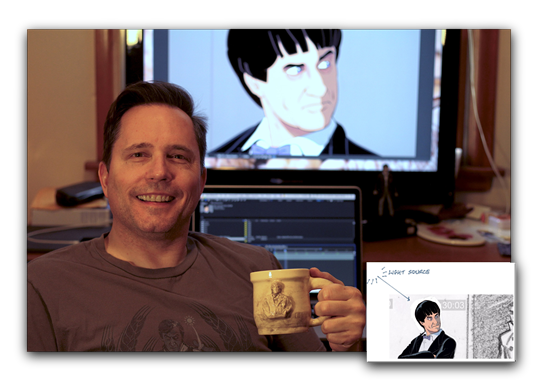
for whatever reason, the company did not use all of Martinís designs, instead designing background characters of their own to animate. Charles asked me if I could take the approved designs from Martin and either rework or replace the animation of the background characters to bring them back in line with the aesthetic that had been originally created. This involved rigging the faces and limbs of the original designs in Photoshop, and then replacing and reanimating them on top of the bodies that had been done by Sun & Moon.
All I had to work with were final renders of the background characters that had been animated already, so I spent a lot of time rotoscoping out the undesired heads and tracking the replacement versions on top of them; as well as masking out hands and arms that werenít working well and attempting to seamlessly drop new versions over them. It was challenging work, but I hope it will be impossible to tell in the final episodes that many of the dancing and singing extras have been ĎFrankensteinedí together.
There was also an important sequence in Episode 1, in which the Doctor sneaks outside the colony to meet with Medok. I was given a key frame of the lighting design for the sequence, and then was tasked with animating the shadows onto both the Doctor and Medok. I used Adobe After Effects to hand-track areas of light and dark onto both characters (similar to what my job was on Shada), animating the shadows as they moved through the light and turned their heads back and forth. This took me about a week to complete, for a sequence which lasts one minute in the final episode. I think it adds a lot of mood and depth to an important and well-animated dialogue scene.
After I had completed all my major work on the episodes, I got to stretch my animation skills by animating a couple of fluid effects shots. One was the water which the Doctor splashes onto his chalkboard equations to rinse them away, and the other was the green slime puddle that Jamie steps into, revealing a pair of goggles underneath. I again used After Effects to create shape layers for the respective fluids, and drew key frames for the action which the program then in-betweened to simulate smooth-flowing liquids.
All I had to work with were final renders of the background characters that had been animated already, so I spent a lot of time rotoscoping out the undesired heads and tracking the replacement versions on top of them; as well as masking out hands and arms that werenít working well and attempting to seamlessly drop new versions over them. It was challenging work, but I hope it will be impossible to tell in the final episodes that many of the dancing and singing extras have been ĎFrankensteinedí together.
There was also an important sequence in Episode 1, in which the Doctor sneaks outside the colony to meet with Medok. I was given a key frame of the lighting design for the sequence, and then was tasked with animating the shadows onto both the Doctor and Medok. I used Adobe After Effects to hand-track areas of light and dark onto both characters (similar to what my job was on Shada), animating the shadows as they moved through the light and turned their heads back and forth. This took me about a week to complete, for a sequence which lasts one minute in the final episode. I think it adds a lot of mood and depth to an important and well-animated dialogue scene.
After I had completed all my major work on the episodes, I got to stretch my animation skills by animating a couple of fluid effects shots. One was the water which the Doctor splashes onto his chalkboard equations to rinse them away, and the other was the green slime puddle that Jamie steps into, revealing a pair of goggles underneath. I again used After Effects to create shape layers for the respective fluids, and drew key frames for the action which the program then in-betweened to simulate smooth-flowing liquids.
COMPLETION AND DELIVERY • • • • • • • • • • • • • • •
• CHARLES NORTON:
In the end, in spite of all our most valiant efforts, we failed to completely make up for lost time and, for the very first time, we were forced to deliver the final master for The Macra Terror later than scheduled. We missed our deadline. In the end, I think we were about 14 hours late all told, delivering on the afternoon of our delivery date, rather than the morning. This may sound incredibly minor, but with such a tight turnaround at the production end, delays really can matter.
We were grading and dropping in audio tracks right up to the last minute, finally delivering on the afternoon of 18th February 2019 - almost exactly a year on from when we started it all.
• CHARLES NORTON:
In the end, in spite of all our most valiant efforts, we failed to completely make up for lost time and, for the very first time, we were forced to deliver the final master for The Macra Terror later than scheduled. We missed our deadline. In the end, I think we were about 14 hours late all told, delivering on the afternoon of our delivery date, rather than the morning. This may sound incredibly minor, but with such a tight turnaround at the production end, delays really can matter.
We were grading and dropping in audio tracks right up to the last minute, finally delivering on the afternoon of 18th February 2019 - almost exactly a year on from when we started it all.
As with anything, there are bits of it that I think work better than others. There are some things that we're very pleased with and other bits that we wish we could have done better. However, on balance, I think it actually all turned out pretty well in the end. I won't be directing any more new Doctor Who animations, so I'm glad that this last one has been as well received as it has. And if you've yet to see it (and assuming I haven't completely spoilt it for you by telling you how we made it) I hope you enjoy it. And thank you to everyone who helped make it possible.
• PAUL HEMBURY:
We're not being self-important about it, but we think that the work we're doing here is important. These stories are missing, many of them presumed lost. They're good stories. There is an incredibly loyal and passionate fanbase who want to see them and the animations that we've done have been increasingly well-received. Therefore, to go back to what I said earlier, if we can make the numbers work, I think that it's something that we would be keen to continue. But, we have to look at it on a project by project basis.
• MARTIN GERAGHTY:
Adrian, Mark, Rob, Graham, Colin, Paul, David, Charles and myself were working very much up to deadline, to both adjust and refine a set of episodes that would pay due and respectable credit to a 52-year-old television production, long since lost in time. The result is something we, as a team of Doctor Who fans are very proud to have been instrumental in bringing to a new audience.
• PAUL HEMBURY:
We're not being self-important about it, but we think that the work we're doing here is important. These stories are missing, many of them presumed lost. They're good stories. There is an incredibly loyal and passionate fanbase who want to see them and the animations that we've done have been increasingly well-received. Therefore, to go back to what I said earlier, if we can make the numbers work, I think that it's something that we would be keen to continue. But, we have to look at it on a project by project basis.
• MARTIN GERAGHTY:
Adrian, Mark, Rob, Graham, Colin, Paul, David, Charles and myself were working very much up to deadline, to both adjust and refine a set of episodes that would pay due and respectable credit to a 52-year-old television production, long since lost in time. The result is something we, as a team of Doctor Who fans are very proud to have been instrumental in bringing to a new audience.
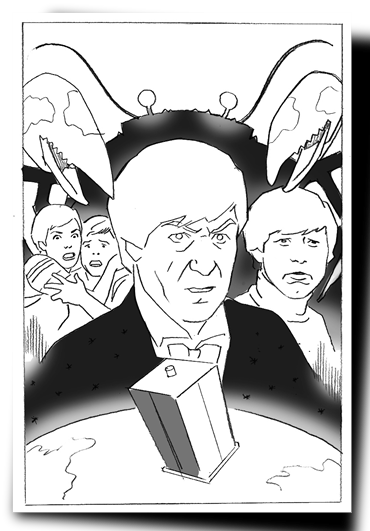
PHOTO GALLERY (Click to enlarge)
